
Defense Business Systems
Investment Management
Guidance
Version 4.1
June 26, 2018

DBS Investment Management Guidance June 26, 2018
Department of Defense Page 2 of 54
Table of Contents
1. Introduction ......................................................................................................................... 5
2. Investment Management Process ......................................................................................... 10
3. Governance ........................................................................................................................ 27
4. Investment Review Roles and Responsibilities ....................................................................... 30
Appendix A: 10 U.S.C. § 2222 ...................................................................................................... 32
Appendix B: Key Terms ................................................................................................................. 33
Appendix C: Acronyms and Abbreviations ...................................................................................... 38
Appendix D: Integrated Business Framework tools ......................................................................... 40
Appendix E: Organizational Execution Plan Portfolio Certification Request Memorandum – Sample .... 41
Appendix F: Out-of-Cycle Portfolio Certification Request Memorandum – Sample ............................. 42
Appendix G: Mandatory Data Elements .......................................................................................... 43
Appendix H: Investment Decision Memorandum – Sample ............................................................... 51
Appendix I: References and Resources .......................................................................................... 54
Table of Figures and Tables
Figure 1 – Integrated Business Framework ..................................................................................... 7
Figure 2 – Integrated Business Management Process Overview .......................................................10
Figure 3 – Organizational Execution Plan Construct ........................................................................14
Figure 4 – Business Capability Acquisition Cycle ............................................................................18
Figure 5 – Out of Cycle Organizational Execution Plan Construct ......................................................26
Figure 6 – Integrated Business Framework tools homepage ............................................................40
Table 1 – Authoritative Data Sources .............................................................................................20
Table 2 – Investment Management Process Timeline ......................................................................24
Table 3 – Required Component Actions for OOC Requests ...............................................................25
Table 4 – DBC Members ...............................................................................................................28

DBS Investment Management Guidance June 26, 2018
Department of Defense Page 3 of 54
Version History
Version
Date
Summary of Changes/Notes
1.0
June 2012
Initial release; preceded by a report to Congress how the DoD
intended to implement the FY12 National Defense Authorization Act
(NDAA) (http://dcmo.defense.gov/ >> Publications)
2.0
April 2013
• Improves alignment of Functional Strategies and Organizational
Execution Plans (OEPs)
• Directs Information Technology (IT) efficiencies with a goal of
10% reduction of Current Services (CS) across portfolios relative
to the prior year OEPs
• Provides guidance for the changes associated with the use of the
authoritative data sources in the Defense Business System (DBS)
investment review and certification process
• Seeks greater awareness of the Department’s Enterprise Resource
Planning (ERP) investments
• Increases visibility into costs of defense business operations with
focus on defense agency operating costs
• Provides guidance for Out of Cycle (OOC) certification requests
• Changes the process for reviewing OEPs submitted by all other
DoD organizational entities not included in the Military
Departments
• Improves the process for asserting Business Enterprise
Architecture (BEA) compliance using Architecture Compliance
and Requirements Traceability (ACART)
3.0
April 2014
• Synchronizes the Integrated Business Framework (described in
section 1.4) with the Planning, Programming, and Budgeting and
Execution (PPBE) process by focusing Defense Business Council
(DBC) reviews of Functional Strategies and OEP not only on
execution year fund certification requests, but also on the Future
Year Defense Program (FYDP).
• Directs identification of BEA operational activities that support
functional strategy initiatives and DBS reported in OEPs. Using
BEA Operational Activities to align Functional Strategies and
OEPs will help ensure planned DBS investments and expenditures
are aligned with DoD's business goals.
• Automates Functional Strategy and OEP content to improve the
DBC’s ability to make informed investment decisions based on
authoritative data and information.
• Improves the process for asserting compliance with the BEA.
• Incorporates review of reported progress toward Functional
Strategy performance measures.
• Defines better selection and control responsibilities within the
management of the capital investments that support business
operations.

DBS Investment Management Guidance June 26, 2018
Department of Defense Page 4 of 54
3.1
April 2014
Minor edits; Not formally released
3.2
April 2014
Minor edits; Not formally released
3.3
October
2014
Updated the OOC process and minor edits
3.4
February
2015
Eliminated Defense Business Systems Management Committee
(DBSMC) references; removed references to business systems used
within Military exchange systems funding by Nonappropriated Fund
(NAF); integrated portfolio management role of a charted Fourth
Estate Working Group
4.0
February
2017
• Clarifies Covered DBS as it applies in the guidance
• Revises thresholds for review/certification: Military Department
CMOs have approval authority for DBS investments below
$250M/FYDP; DCMO has approval authority for Fourth Estate
DBS investments $1M / FYDP and all DBS investments in excess
of $250M / FYDP
• Implements a process to meet 10 U.S.C. § 2222 requirements for
acquisition strategy, required documentation and auditability
compliance
• Implements the new 10 U.S.C. § 2222 requirement that DoD
business processes be continually reviewed and revised by
requiring components to report the results of this review as part of
their OEP annual review of systems
•
Codifies Defense Business Council as an advisory authority
4.1
April 2018
Minor edits;
• Changed DCMO to CMO throughout
• Added additional information to support business capability
acquisition cycle (BCAC), functional strategies and the BEA
• Updated definitions of core and legacy systems
• Removed the Appendix A NDAA text and added a link
• Minor updates to the purpose statement; timeline; out of cycle
table
• Updates made to include Acquisition and Strategy FS business
area as applicable
• Updated Appendix C Acronyms and Abbreviations
• Updated Appendix G Mandatory Data Elements and text for
business process reengineering (BPR) to add legacy systems
option and other editorial edits.

DBS Investment Management Guidance June 26, 2018
Department of Defense Page 5 of 54
1. Introduction
1.1. Background and Purpose
The DoD must continue to reform its business practices, improve its business operations
performance, and achieve efficiencies and effectiveness in order to achieve the Secretary of
Defense’s and Agency Strategic Plan’s (ASP) goal to reform the Department to reinvest
resources for warfighter priorities to the direct support of combat, combat support and combat
service support elements of the DoD. Achieving this goal requires reengineering business
processes; demonstrating beneficial returns on new and existing information technology (IT)
investments;
1
knowing what it costs to deliver business capabilities; and effective
implementation of the Capital Planning and Investment Control (CPIC) process for investments
in information technology (IT) that support these business processes and capabilities. This
document and the issuances listed below constitute the guidance required by title 10 U.S. Code
(10 U.S.C) § 2222 (c)(1):
• DoD Instruction 5000.75 “Business Systems Requirements and Acquisition” and
supporting acquisition policy and guidance
• DoD Directive 7045.14 “The Planning, Programming, Budgeting and Execution (PPBE)
Process” and supporting policy and guidance
• DoD Financial Management Regulation (FMR) Volume 2B, Chapter 18 “Information
Technology” and supporting IT budget policy and guidance
10 U.S.C. § 2222 provides requirements for annual review and approval for covered defense
business systems (DBSs) before they can proceed into development. If development is not
required, then the annual review and approval is needed prior to production, fielding, or
continued sustainment. 10 U.S.C. § 2222 gives greater responsibilities to Military Department
Chief Management Officers (CMOs) and defines the statutory thresholds for a covered DBS.
However, Military Departments and Fourth Estate
2
CMOs may lower thresholds used internally
as discussed later in this document.
With these laws, regulations and policies, the DoD has implemented processes to manage a well-
defined IT investment portfolio for the DoD Business Mission Area (BMA) and all DBSs. The
1
Return can be monetary or non-monetary, or a combination, with factors to include improved mission performance,
reduced business process or IT cost, improved process time, increased quality, better agility, improved security,
improved compliance, improved reporting, and/or increased user satisfaction.
2
Fourth Estate refers to Office of the Secretary of Defense (OSD), the Office of the Chairman of the Joint Chiefs of
Staff and the Joint Staff, the Combatant Commands, the Defense Agencies, the DoD Field Activities, and all other
organizational entities in the DoD that are not in the Military Departments. The CMO of the DoD is also the Fourth
Estate CMO.

DBS Investment Management Guidance June 26, 2018
Department of Defense Page 6 of 54
investment management process works in conjunction with the Planning, Programming,
Budgeting, and Execution (PPBE) process described in DoD Directive 7045.14 by focusing on
the strategy, goals and planned spending for business operations, to include DBS.
The DoD established the Defense Business Council (DBC) as the principal subsidiary
governance body to the Deputy’s Management Action Group for defense business operations.
The DBC also assumes the role of the Department's Investment Review Board (IRB) for DBS
investments. The DBC will refer to both the IRB and the DBC now codified as an advisory
authority in 10 U.S.C. § 2222.
This guidance supersedes “Guidance for Review and Certification of Defense Business Systems”
Version 4.0, dated April 16, 2017.
1.2. Summary of Changes
This guidance incorporates lessons learned from the previous investment review cycle.
Additionally, the guidance reflects the establishment of the DoD Chief Management Officer
(CMO).
3
The CMO continues as the CMO for the Fourth Estate and retains the threshold for the
review and certification of DBS investments at $1M over the FYDP.
1.3. Scope
The guidance is intended for DBS investment management process stakeholders, including
Principal Staff Assistants (PSAs), Military Department CMOs, affected combatant commanders,
directors of defense agencies, directors of DoD field activities and program managers. This
guidance applies to all DoD organizations and to the architecture, planning, budgeting and
obligation of funds, regardless of funding type for DBS investments.
The guidance does not apply to national security systems (NSS) or DBS used exclusively by and
within the defense commissary, exchange system or morale, welfare and recreation using non-
appropriated funds. An IT system which otherwise meets the definition of a DBS but has been
determined to not be managed as a DBS solely because it processes classified information or is
connected to a classified network or uses non-appropriated funds should be carefully assessed to
ensure relevancy of the DBS classification. Failure to comply with the certification requirements
of 10 U.S.C. § 2222 may result in a violation of 31 U.S.C. § 1341(a)(1)(A), otherwise known as
the Anti-deficiency Act.
For the Fourth Estate portfolios, the DoD CMO serves as the CMO. In accordance with 10
U.S.C. § 2222 and DoD Instruction 5000.75, the CMO designates the Fourth Estate minimum
threshold at $1M over the period of the current FYDP. The Military Department CMOs have
3
The term DoD CMO is used to reflect there is also a CMO of each military departments
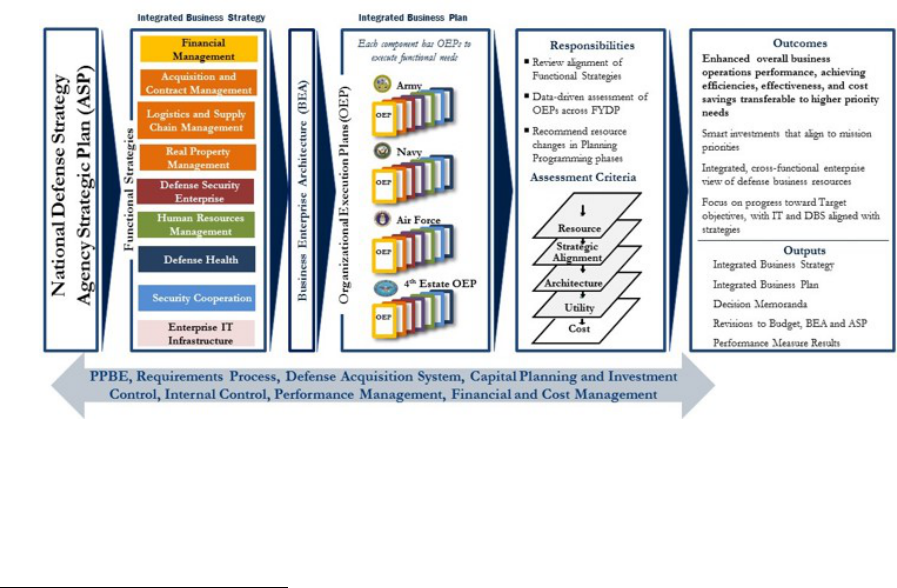
DBS Investment Management Guidance June 26, 2018
Department of Defense Page 7 of 54
established minimum thresholds, based on their approval authorities, for any DBS investment
$250M or below over the period of the current FYDP. A Priority DBS is any DBS investment in
excess of $250M over the period of the current FYDP or as designated by the CMO as a Priority
DBS. The DoD CMO is the approval authority for all Priority DBS.
For the purposes of this guidance, the term ‘covered DBS’ includes those DBS investments
greater than the minimum thresholds stated above as well as the statutory thresholds defined in
10 U.S.C. § 2222.
1.4. Integrated Business Framework Overview
The Integrated Business Framework (IBF)
4
provides the overarching structure used to help
understand how the Department governs and manages business operations to include business IT
investments. The IBF drives the creation of aligned business strategies, investment plans,
component execution plans, and the measurement of outcomes. The framework facilitates a
cross-functional, enterprise-wide view for the governance and review of DBS and certification of
covered DBS over the period of the current FYDP. One of the elements of the ASP, as
illustrated in Figure 1, is the enterprise plan for improving DoD's business operations.
Figure 1 - Integrated Business Framework
Guided by the ASP, the PSAs, as the business line owners, develop and periodically refine the
Functional Strategies. The Functional Strategies are an important element within the investment
management process because they establish strategic direction for PPBE activities. Reflecting
4
The IBF originated with the DoD implementation of section 901 of the FY2012 NDAA.

DBS Investment Management Guidance June 26, 2018
Department of Defense Page 8 of 54
the planning associated with business operations and the IT portfolios that support them, the
Functional Strategies articulate business outcomes, priorities, measures, and standards. An
Organization Execution Plan (OEP) is developed by each organization and specify the
organization’s annual certification request. The OEP articulates an organization’s approach to
align with the Functional Strategies and produce business results. The objective is to enable end-
to-end integration, improve business operations, and leverage the appropriate technology to
deliver agile, effective, and efficient business solutions that support and enable the Warfighter.
Within the IBF, the Functional Strategies and OEPs inform the Business Enterprise Architecture
(BEA) and support an integrated business strategy for the DoD. The IBF will continue to mature
as the DoD achieves outcomes.
Given the IBF focus on efficient and effective performance management, the IBF integrates with
the DoD’s PPBE annual resource allocation process, the Defense Acquisition System and the
management internal control program.
5
The IBF also utilizes resource management principles
though cost management and financial accounting to support decision-making and to
demonstrate DoD accountability externally. The DoD Performance Management Framework, as
outlined in the ASP and Office of Management and Budget Circular A-11, institutes a
disciplined approach to providing leadership with a linkage between performance and resourcing
management through strategy, planning, monitoring, reporting and managing progress.
Performance and resourcing management are integral components in the IBF that helps to
enhance the overall business operations performance, achieving efficiencies and cost savings.
The IBF also incorporates the CPIC process required by the Clinger-Cohen Act of 1996 for
selecting, managing, and evaluating the results of DoD’s investments in DBS. The IBF is
broader and addresses the Department’s business operations, business processes, and business
strategy, and CPIC is incorporated within the IBF to focus on IT investments. It also encourages
the use of performance and results based management business process reengineering prior to
investing in IT. Organizations develop and review their portfolios based on investments for
business functions and activities in both Core (part of the target environment) and Legacy
(scheduled for termination within 36 months) systems and services. Portfolios are evaluated for
alignment with applicable Functional Strategies and assessed from multiple perspectives such as
strategic alignment, performance, risk, affordability, business value, return on investment (ROI),
cost, duplication of capabilities, architecture alignment and compliance, interoperability,
efficiency, and effectiveness. The DBC and components establish selection and control criteria
for the management of the portfolio to achieve the outcomes and performance required. Review
criterion ensures that IT projects and systems support the organization’s ongoing and future
5
The PPBE process, defined in DoDD 7045.14, is the annual resource allocations and requirements process that
provides validated and prioritized capability requirements. The Defense Acquisition System, defined in DoDD 5000.01
and DoDI 5000.75, is a process that provides effective, affordable, and timely systems to users. Internal control
program, defined in DoDI 5010.40, helps an entity run its operations efficiently and effectively, report reliable
information about its operations and comply with applicable laws and regulations.
DBS Investment Management Guidance June 26, 2018
Department of Defense Page 9 of 54
business needs. The DBC evaluates portfolios to ensure compatibility with the ASP and
Functional Strategies and provides budget and certification adjustment recommendations where
necessary.
The approval of certification requests declares that a DBS meets 10 U.S.C. § 2222 requirements
to obligate funds. The DBC may also submit issues into the PPBE process where required.
Portfolios should demonstrate progress in portfolio performance to optimize portfolio cost and
ensure investments contribute to a lower total cost of business operations and / or deliver
required capabilities to the Warfighter.
This guidance implements the new 10 U.S.C. § 2222 requirement that DoD business processes
be continually reviewed and revised. The BEA acts as a blueprint to guide the development of
integrated business processes within the DoD. Organizations are to regularly review their
business processes and those of the DoD enterprise as appropriate and revise or make
recommendations to revise them. Revision of these processes occurs through business process
reengineering and continuous process improvement.
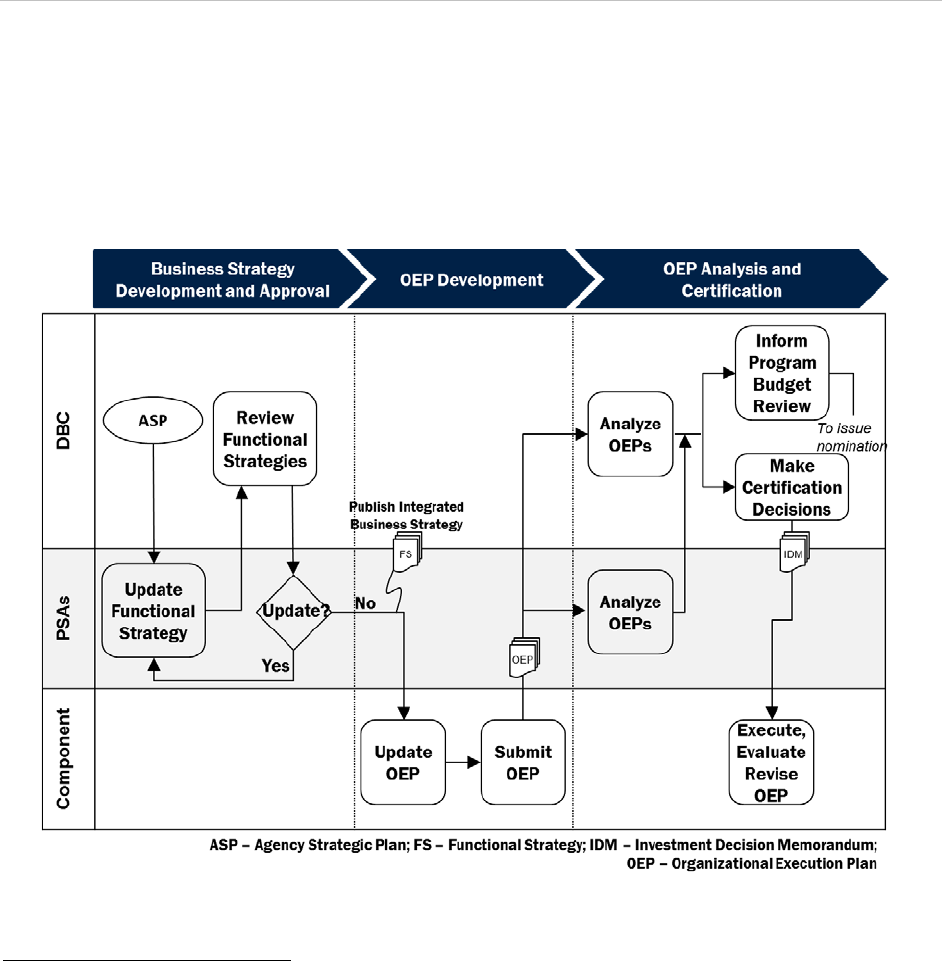
DBS Investment Management Guidance June 26, 2018
Department of Defense Page 10 of 54
2. Investment Management Process
The annual investment management process includes ASP and Functional Strategies as inputs
used by the appropriate DoD PSAs as illustrated in Figure 2. Organizations then use these
business strategies and priorities to develop and refine their portfolios. The integrated business
strategy will serve as additional guidance to the Pre-Certification Authorities (PCAs)
6
for their
budgets in the DoD business mission area. The Functional Strategies may include evaluation
criteria that the PSA will use to evaluate budget and certification requests proposed by the PCA.
The PSA may also identify DBS that should be considered by the PCA for retirement based on
misalignment to DoD business goals, costs, duplication or other factors.
Figure 2 – Integrated Business Management Process Overview
6
The term PCA no longer exists in 10 U.S.C. § 2222 however the term is being retained to address the compliance
determinations that will continue to be made by the component level leadership before approval by the appropriate
approval officials, the DCMO and the Military Department CMOs. For example, the component PCA will continue to
make system and business system portfolio BEA compliance determinations in advance of the appropriate approval
official determinations based on PCA determinations. Component PCAs will continue to be designated senior
executives, flag officers, or general officers.
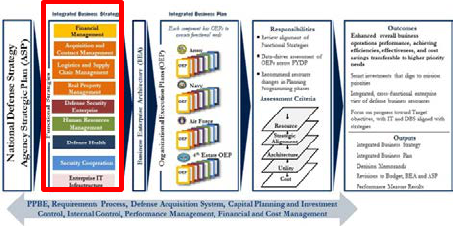
DBS Investment Management Guidance June 26, 2018
Department of Defense Page 11 of 54
OEPs will be representative of the organization’s covered DBS budget and certification request
and must demonstrate the organization’s efforts to align DBSs with outcomes and Functional
Strategies to drive value in the DoD’s business IT investment portfolio.
As the plan matures, OEPs will represent more than the DBS investment IT resources to become
the organization’s integrated business plan to achieve the outcomes and goals articulated in both
the ASP and Functional Strategies. OEPs must also identify the component’s business goals.
The DBC can review each OEP and make recommendations to the Chair regarding certification.
Additionally, the DBC may issue decision documents where appropriate, to the Director, Cost
Analysis, and Program Evaluation (DCAPE) and the Under Secretary of Defense (Comptroller)
(USD(C)), for proposed DBS investment budgeted funds which are not aligned to Functional
Strategies.
2.1. Functional Strategies
Integral to the IBF, Functional Strategies
represent a crucial component of the strategic
planning process for the BMA. Functional
Strategies articulate each functional area’s
strategic vision, business outcomes, and
measurable targets over the next three to five
years. Functional Strategies should be aligned
to the ASP and the Department’s Reform
initiatives in order to ensure integration,
alignment, and interoperability across the DoD. They will be used to provide guidance and
prioritize activities as they propose how to deliver the DoD’s business priorities and assemble
DBSs into portfolios, known as OEPs. Functional Strategies inform the re-selection of DBS
investments via certification in the portfolio prior to the fiscal year of execution and provide
direction used to inform IT investment decisions now and in the future.
Functional Strategy Business Areas
Functional Strategies are developed by the appropriate PSA for business areas and captured
within the Integrated Business Framework – Data Alignment Portal (IBF-DAP), an on-line tool,
provided by the Office of the Chief Management Officer (OCMO). The IBF-DAP enables
informed DBS decisions based on data (see Appendix D). An “other” business area is included
to address DBSs that do not map to one of the existing areas or are not specifically listed in 10
U.S.C. § 2222 (j)(1). The business area “other” does not have a Functional Strategy but PSAs
may develop one as the business alignment process continues to evolve. These categories may
result in additional content within the BEA to address these functions, activities, or capabilities.
Current functional strategy business areas are listed below:
• Acquisition and Contract Management (Under Secretary of Defense for Acquisition and
Sustainment (A&S))

DBS Investment Management Guidance June 26, 2018
Department of Defense Page 12 of 54
• Logistics and Supply Chain Management Readiness (Under Secretary of Defense for
A&S)
• Defense Health (Under Secretary of Defense for Personnel and Readiness)
• Defense Security Enterprise (Under Secretary of Defense for Intelligence)
• Real Property Management (Under Secretary of Defense for A&S)
• Enterprise IT Infrastructure (DoD Chief Information Officer (CIO))
7
• Financial Management (Under Secretary of Defense (Comptroller))
• Human Resources Management (Under Secretary of Defense for Personnel and
Readiness)
• Training and Readiness (Under Secretary of Defense for Personnel and Readiness)
• Security Cooperation (Under Secretary of Defense for Policy)
• Other
8
All DBS from all functional areas within the BMA must adhere to the business outcomes,
standards, measures, and planned initiatives specified in the applicable functional strategies.
Multiple Functional Strategies can affect any single business system.
Functional Strategy Elements
The IBF-DAP will capture the required sections for each Functional Strategy element listed
below (see Appendix D). The DBC may review a Functional Strategy briefing generated from
data captured in the IBF-DAP.
• Functional Overview: This section of the Functional Strategy defines the mission and
vision.
7
Guidance in the Enterprise IT Infrastructure Functional Strategy applies to all DoD business IT systems. The strategy
for Enterprise IT Infrastructure provides the DoD CIO’s requirements for all DBS to ensure systems can operate in the
Joint Information Environment (JIE). Due to the crosscutting nature, the Enterprise IT Infrastructure is not a business
system portfolio and should not be selected in DITPR as the functional area for any DBS system.
8
The Other category includes functions and systems that do not fit into another function and typically includes case /
correspondence / task / records management, project or program management, library management, administrative
management, business intelligence, inspector general, or other staff functions.
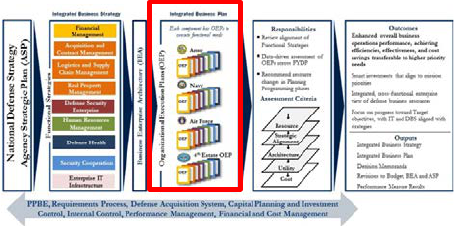
DBS Investment Management Guidance June 26, 2018
Department of Defense Page 13 of 54
• Functional Strategy Business Outcomes: Each Functional Strategy business outcome
should demonstrate a clear linkage to ASP goals and Functional Strategy initiatives. The
Functional Strategy business outcomes should address all applicable ASP line items.
This section of the Functional Strategy defines business outcomes that are critical to
achieving DoD business goals. The business outcomes must include measurable targets,
risks, and challenges. OEPs submitted by organizations should align to the business
objectives and must measure their progress toward achieving the business goals.
• Functional Strategy Initiatives: This section of the Functional Strategy defines
initiatives deemed critical to the achievement of one or more business outcomes. The
Functional Strategy initiatives must demonstrate measureable targets, risk and challenges
(e.g. interdependencies), and assess progress toward accomplishment of business
outcomes. An initiative should state whether compliance with a standard or the use of an
enterprise system is required. The OEPs submitted by organizations should subsequently
align to these strategic initiatives and support metric progress. Each Functional Strategy
should also demonstrate a clear linkage in IBF DAP between the Functional Strategy
initiatives to the Operational Activities and applicable Laws, Regulations and Policies in
the BEA.
• Business Outcome and Prior Year Initiative Progress: This section documents
progress toward business outcomes identified in prior Functional Strategy’s performance
results in addition to percentage completeness relative to the target.
2.2. Organizational Execution Plan
The primary focus of the OEP is the annual
identification and prioritization of DBS
investments over the period of the current
FYDP as aligned with the strategic direction
from applicable Functional Strategies. OEPs
represent the ongoing results of an
organization’s CPIC effort for the analysis,
selection, control, and evaluation of its
portfolio of DBS used to support business
operations focusing on the year of execution. The results of an organization’s plan for managing
its portfolio of business IT investments in alignment with the Functional Strategies and ASP are
also represented. As a result of the CPIC control and evaluation phases, the OEP highlights
changes from the previous plan to help demonstrate aspects of component compliance with 10
U.S.C. § 2222.
The OEP certification review is performed annually on the approaching fiscal year of execution.
The year of execution budget amounts will form the basis of the certification request submissions
for the portfolio. Review of the OEP consists of the entire DBS portfolio as well as past and
future year budgets.
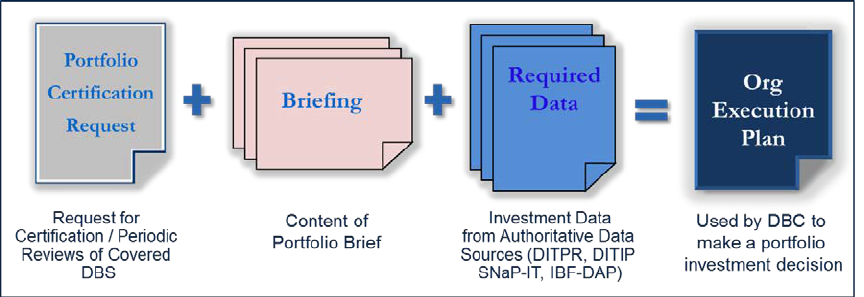
DBS Investment Management Guidance June 26, 2018
Department of Defense Page 14 of 54
OEPs include data from authoritative sources that help support investment management
decisions. All DBS investments across the period of the current FYDP are included in the OEP
by virtue of being in the DoD Information Technology Portfolio Repository (DITPR), DoD IT
Investment Portal (DITIP), and Select and Native Programming Data Input Systems for IT
(SNaP-IT) and are therefore available for DBC review. However, the OEP certification review
mainly focuses on the covered DBS investments.
Information for each DBS as identified in Appendix G must be documented within the DoD’s
authoritative data sources prior to the initiation of DBC reviews on a date that will be established
by the DBC chair. Covered DBSs will be at risk of not receiving certification and omitted as a
resource requirement within the future year budget if these Mandatory Data Elements are not
complete.
Organizationally, there is one OEP for the Fourth Estate made up of individual component OEP
chapters, and there is one OEP for each of the Military Departments made up of chapters. The
organization develops and submits the OEP or OEP chapter to the DBC by issuing a Portfolio
Certification Request (PCR). The PCR template is provided in Appendix E. In addition to the
PCR, the OEP includes an agency portfolio briefing developed using the Integrated Business
Framework – Data Alignment Portal (IBF-DAP) and validated system data from the other
authoritative data sources. Figure 3 illustrates the construct of an OEP.
Figure 3 – Organizational Execution Plan Construct
DBS Investment Management Guidance June 26, 2018
Department of Defense Page 15 of 54
Portfolio Certification Request
The PCR is the document developed by the PCA that asserts compliance with goals and
initiatives articulated within functional strategies and the requirements of 10 U.S.C. § 2222. The
PCR contains an update to the status of outstanding Investment Decision Memorandum (IDM)
conditions. See Appendix E for a PCR template.
When preparing a PCR, the PCA must review the portfolio and determine if each IT investment
is a DBS based on the definition provided in 10 U.S.C. § 2222 (i)(1). If the answer to any of the
questions below is “yes” then the IT investment likely meets the intent and therefore falls under
the authority of 10 U.S.C. § 2222.
• Does the IT investment support a business operation, function, or activity that meets the
definition of a DBS?
• Does the IT investment used to support a business operation, function, or activity meet
the definition of an information system, as defined in title 44 U.S.C. § 3502?
• Does the IT investment rely on other DBSs for interoperability?
• Does the IT investment rely on a level of adherence to the BEA to effectively guide,
constrain and permit interoperable DBSs solutions or support the governance framework
for DBSs?
• Does the IT investment involve inherently managerial functions or provide business
functions or capabilities such as strategic planning, case / correspondence / records
management, project or program management or other staff functions performed at a
management headquarters level?
As referenced in Section 1.3, certification requests for covered DBSs are not limited to systems
that reside on the Non-Classified Internet Protocol Router Network (NIPRNet). If the DBS
performs a business function, such as acquisition, financial management, logistics, strategic
planning and budgeting, installations and environment and human resource management then it
may be a candidate for certification.
Once the PCA determines the portfolio of investments that are DBSs, the PCA must determine
how the proposed DBS (see Appendix A):

DBS Investment Management Guidance June 26, 2018
Department of Defense Page 16 of 54
1) Comply with the Functional Strategies and are (or will be) in compliance with the BEA
9
2) Have undertaken appropriate Business Process Reengineering (BPR) efforts to ensure
that:
a) The business process supported by the DBSs are as streamlined (or are being
streamlined) and efficient as practicable as well as to match best commercial
practices, to the maximum extent practicable, so as to minimize customization of
commercial business systems and
b) The need to tailor commercial-off-the-shelf (COTS) systems to meet unique
requirements or incorporate unique interfaces has been eliminated or reduced to the
maximum extent practical;
3) Have valid, achievable requirements and a viable plan for implementing those
requirements (including, as appropriate, market research, business process reengineering
and prototyping activities);
4) Have an acquisition strategy designed to eliminate or reduce the need to tailor
commercial off-the-shelf systems to meet unique requirements, incorporate unique
requirements or incorporate unique interfaces to the maximum extent practicable; and
5) Comply with the DoD’s auditability requirements.
PCAs also classify DBS as “Core” or “Legacy” by their establishment of lifecycle end dates in
DITPR. A core DBS is an enduring system with a sunset date greater than 36 months.
10
A
Legacy DBS is a system with a sunset date within 36 months. FYDP budget data must
appropriately reflect this determination. For Core DBSs, the organization must ensure that the
DBS is compliant with all applicable BEA regulations, policy, data standards, and business rules
and that appropriate BPR efforts have been undertaken. DBSs currently in sustainment with no
future modernizations planned are not required to create a requirements plan document or an
acquisition strategy that meets the new requirement. Components will identify these DBSs for
DBC or Military Department CMO review.
9
Portfolio BEA compliance determinations required by 10 U.S.C. § 2222 (g)(1)(b) will be made by the PCA, the Military
Departments CMO and the DBC as appropriate. PCAs should note in their PCR memo whether portfolio
determinations were conducted. As DoD policy, at the portfolio level, the “business system portfolio will be in
compliance with the BEA developed pursuant to subsection (e) or will be in compliance as a result of modifications
planned.” If there is one or more noncompliant system in a portfolio, the portfolio will always be planned compliant.
10
Core and legacy dates are generally calculated based on the start of the particular fiscal year of analysis, however any
base date could be used.

DBS Investment Management Guidance June 26, 2018
Department of Defense Page 17 of 54
The CMO has specified that organizations must perform BEA assessments in IBF-DAP and must
assert compliance in DITIP to ensure BEA assessments are consistent and rigorous. Enterprise-
wide use of the functionality within IBF-DAP has the additional benefit of creating an
authoritative data source of BEA compliance assessment information. The DBC leverages BEA
compliance assessment information as part of the certification process. Legacy DBSs are not
required to assess or assert compliance with applicable BEA requirements but they are required
to perform mappings in IBF-DAP to applicable BEA Operational Activities, Business
Capabilities, Processes, System Functions, and End-to-End (E2E) Processes. DITIP will
document covered DBS assertions for compliance with requirements plan documents, acquisition
strategy, and auditability assertions.
The PCA is responsible for determining whether appropriate BPR
11
has been accomplished or is
planned prior to submitting request for investment certification. All DBS must be aligned to
appropriate business processes within the BEA. DITIP will document BPR covered DBS
assertions and the PCR will include an overall statement of compliance.
When a DBS investment contains resources provided from multiple organizations, the PCA for
the executive agent / primary investment owner of the DBS investments is responsible for
coordinating with the resource providers to ensure the investment reports all known resources in
SNaP-IT and the PCR addresses the entire amount expected for obligation. In order to avoid
duplication, there is also a responsibility upon the PCA within the contributing organizations to
ensure resource contributions to DBS investments within other organizations’ portfolios are
correctly documented in SNaP-IT. The executive agent / investment owner must make the
certification requests for systems with shared funding in SNaP-IT. This direction is similar to
the budget request responsibilities defined in DoD Financial Management Regulation Volume
2B, Chapter 18.
Once the PCA has determined the DBSs are compliant or planned compliant, the PCA must
determine if each DBS investment is covered based on the definition provided in 10 U.S.C. §
2222 (i)(1), as well as any lower thresholds established by the CMO.
The PCA is responsible for submitting certification requests for each covered DBS in DITIP.
The amount and appropriation type of funds associated with each system certification request
should be in agreement with the amount and type in the DoD IT budget exhibit data in SNaP-IT.
Deviations must be justified with an explanation entered in the DITIP. Certification is by year of
obligation. In cases where the appropriation allows obligation over more than one program year,
the program year field will identify the year. However, any deviations between DoD IT budget
exhibit data for a specific program year and corresponding certification request amount require
explanation. DITIP will document the certification requests and associated explanations.
Appendix G provides the compliance options available for each 10 U.S.C. § 2222 (g) item. Final
11
Title 10 § 2222 (a) and (b)
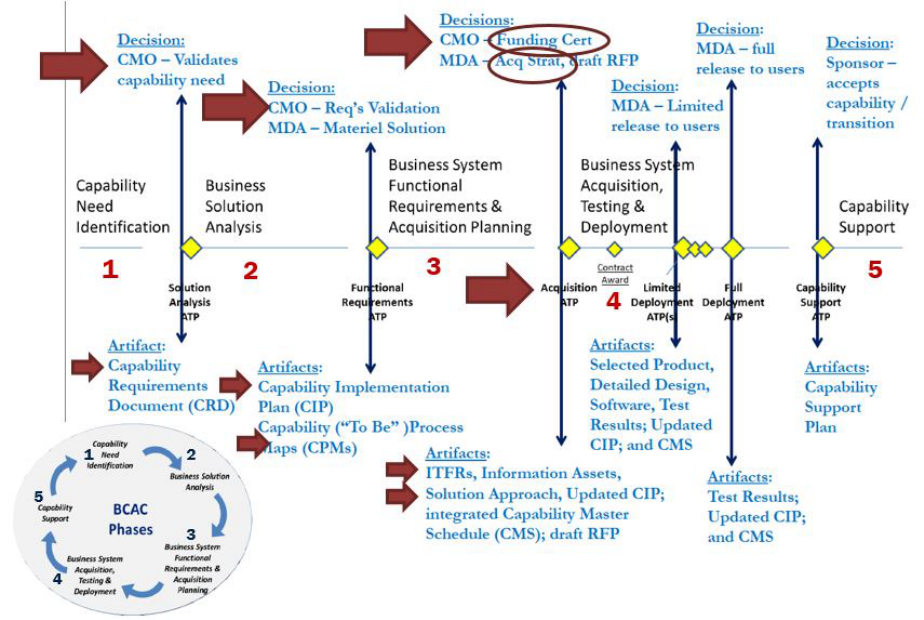
DBS Investment Management Guidance June 26, 2018
Department of Defense Page 18 of 54
certification amounts and associated actions, conditions, or comments will also be documented in
DITIP.
All requests for review and certification of covered DBS that include funding for Development /
Modernization (Dev / Mod) must have approved documentation as identified in DoD Instruction
5000.75. Figure 4 illustrates the business capability acquisition cycle (BCAC) process for
business system requirements and acquisition, its phases, and the CMO decisions. For the
Acquisition authority to proceed (ATP), per 10 U.S.C. § 2222 (h), the relevant CMO § 2222
certification and approvals must be made before the milestone decision authority (MDA)
authorizes acquisition of the business system and approves continued execution of the updated
implementation plan.
Certification under § 2222 for Dev / Mod funding typically would review the following
Acquisition ATP documentation to ensure § 2222 (g) requirements (BPR; BEA compliance;
valid, achievable requirements and a viable plan for implementing those requirements;
acquisition strategy; auditability requirements) are met: the implementation plan, definition of IT
functional requirements, and overall solution approach, as well as previous phase ATP
documentation, to include the capability requirements document and capability “to-be” process
maps. Certification under § 2222 for current services (CS) funding would assess confirmation
that the covered defense business system program continues to satisfy the requirements.
Figure 4 - Business Capability Acquisition Cycle
DBS Investment Management Guidance June 26, 2018
Department of Defense Page 19 of 54
Definitions for Dev / Mod and Current Services are defined in the DoD FMR 7000.14-R,
Volume 2B, Chapter 18.
Organizational Execution Plan Briefing Content
The OEP provides critical information to support decision-making for future year programming,
budgeting, and annual certification of covered DBS. The OEP includes an agency portfolio
briefing developed using the Integrated Business Framework – Data Alignment Portal (IBF-
DAP). Instructions that conform to the OEP specifications in this section are also included in
IBF-DAP. At a minimum, IBF-DAP input for the briefing will address the following:
• Portfolio Business Summary: Introduce the portfolio from a business operations
perspective. Summarize the major business process(es), functions, activities, and
outcomes supported by the DBS with relevant annual high-level financial information as
to the costs of the business operations, if known. Also, provide and explain the key cost
drivers of the business operations. Cost drivers are factors of a particular activity or the
unit of an activity that causes the change of an activity cost.
• Strategic Alignment: Identify the portfolio goals in order to highlight how
improvements in business operations and cost savings will be made and how they are
essential to achieving the integrated business strategy. Show how the Component’s OEP
aligns with the initiatives of the appropriate Functional Strategy(ies) and document how
investments align to the functional strategy initiatives, by using Unique Investment
Identifiers. Goals will include portfolio priorities, objectives, or outcomes. Also, include
cost and time estimates to implement a functional strategy initiative.
• Performance Measures: Document business outcome measures and targets related to
the strategy and associated DBSs – especially with regard to progress against the
Functional Strategy targets. DITPR and other sources, such as acquisition information
repositories, will provide lifecycle data for milestone information.
• Portfolio Accomplishments: Report on the control and evaluate phases of CPIC and the
results of business process reengineering. Identify major business results / outcomes
bound by a link to measurable benefits that were realized within the fiscal years
preceding the OEP and not previously reported. Emphasize results that lower the actual
cost of business operations and reduce redundancy in IT. This should be a higher-level
summary report.
• PCA Review Results: Provide a summary of results of the PCA review required by 10
U.S.C. § 2222 (g) for covered DBS and 10 U.S.C. § 2222 (a) for review of business
processes. Results will include any DBSs with a change in transition plan state and the
reason for the change, any changes in termination dates of legacy DBSs, any revision of
milestones and performance measures in the previous fiscal year, progress against BEA
or BPR plans; and any significant changes in plans such as funding amounts or
certification requests not recommended by PCA. The results should also include the

DBS Investment Management Guidance June 26, 2018
Department of Defense Page 20 of 54
PCA criteria used for selecting investments for certification and investment alignment to
functional strategy initiatives and criteria for reviewing business processes.
• Roadmap to the target environment: Show how systems align to the desired end state
(including sunset dates or timeframes and interoperability with other systems as
appropriate). Include any systems that have been sunset. Prior year outcomes should be
included to highlight systems planned to sunset in the prior OEP submission and the
eliminations that actually occurred. The roadmap presented must be consistent with the
data entered into DITPR and the FYDP budget data. The roadmap should also address
system changes related to a business strategy initiative, such as a plan for transitioning to
a mandatory enterprise system.
• Portfolio Risks and Challenges: Describe risks or challenges that inhibit the
Component’s ability to reach its desired end state. If applicable, address risks and
challenges associated with becoming fully BEA compliant. These risks or challenges
could include BEA and BPR compliance matters such as use of mandatory standards or
enterprise systems stated in Functional Strategies or a lack of needed standards or
enterprise systems. Risks applicable to the entire DoD such as sequestration should not
be included. Many system and service investments that deliver services across multiple
business areas may align to more than one Functional Strategy and more than one
initiative. Systems must be identified with the functional area that aligns closest to the
system’s primary business area to enable an efficient and effective review. Regardless of
the identification, DBS within a functional area will normally align to initiatives within
multiple Functional Strategies and thus may require resources to address the initiatives
within the different functional areas.
Organizational Execution Plan Required Data
Component system owners are required to provide a standard set of minimum data elements in
the authoritative data sources identified in Table 1 no later than the date prescribed by the DBC
chair for the investment review. This requirement ensures that DITPR, SNaP-IT, IBF-DAP, and
DITIP have accurate and complete information for the data elements identified in Appendix G.
This authoritative data facilitates in-depth analysis that informs the DBC review and
certification. Data analytics will be performed at the functional level for each organization and
functional area as well as across organization and functional area. DBSs that do not have the
data required in Appendix G will be at risk of not receiving certification.
Authoritative Source
Type
Information Contained
DoD IT Portfolio Repository (DITPR)
Database
Defense Business System Attributes
Select and Native Programming Data
Input Systems for IT (SNaP-IT)
Database Budget Data
Integrated Business Framework Data
Alignment Portal (IBF-DAP)
Portal OEP alignment for Strategy and BEA
DoD IT Investment Portal (DITIP) Portal
Merged Source for DBS Certification
Requests
Table 1 Authoritative Data Sources
DBS Investment Management Guidance June 26, 2018
Department of Defense Page 21 of 54
Organizational Execution Plan Submission Requirements
OEP data must be made available in DITPR, IBF-DAP, SNaP-IT, and DITIP. The PCR OEP
memorandum will be uploaded to the OEP module in IBF-DAP and the OEP brief will be
generated. OEP submissions are to be submitted no later than the date established by the DBC
chair. Defense Agencies and Field Activities should submit one OEP for all business areas in
coordination with the appropriate PSA.
2.3. Organizational Execution Plan Evaluation Process
OEPs will be evaluated for alignment with applicable Functional Strategies and assessed from
multiple perspectives such as progress toward the target environment, alignment to lines of
business and architecture, business value / ROI, cost, interoperability, efficiency, risk, and
effectiveness. OEPs will undergo a CMO review to create investment awareness and assist the
DBC in understanding the organization’s capabilities in a given functional area. The review
helps determine whether OEPs meet the requirements of Functional Strategies and identify any
gaps between the OEP and the Functional Strategies. Reviews will encompass both a functional
and organizational perspective.
The Fourth Estate Working Group will review the combined Fourth Estate OEP and provide
recommendations prior to review by the DBC. Military Departments will brief results of their
review and approvals to the Fourth Estate Working Group and DBC.
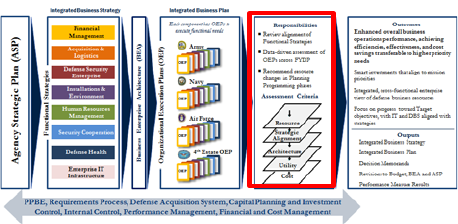
DBS Investment Management Guidance June 26, 2018
Department of Defense Page 22 of 54
General Review Criteria
As illustrated in the IBF, the DBC will use the
following criteria to evaluate OEPs for
certification:
Compliance: The DBC will assess the
determination made by the PCA to ensure that
the portfolio and each applicable DBS are
compliant with 10 U.S.C. § 2222.
Strategic Alignment: The DBC, assisted by the PSA, will assess the viability of the
organization’s business plan, as reflected in proposed investments, to result in specific
improvements in business operations and cost savings and the degree of alignment to strategic
goals and missions and the organization’s lines of business. In addition, the DBC will assess the
degree to which investments are being managed in accordance with the budget guidance
reflected in Functional Strategies, CPIC process and DoD’s Better Buying Power guidance, and
key focus areas / priorities and how they align to investment requests.
Utility: The DBC will assess the portfolio’s ability to deliver required capabilities and provide
performance results, efficiency and effectiveness for a given function as reflected in the
alignment to Operational Activities within the BEA and the progress toward the target for
measures identified in Functional Strategies or OEPs.
Architectural Alignment: The DBC will assess portfolio inter / intra dependencies, architecture
alignment, interoperability, duplication of capabilities, and redundancies, for both processes and
systems. This includes assessing the ability for systems and processes to routinely produce
verifiable, timely, accurate, and reliable business and financial information for management
purposes; and integrating budget, accounting, and program information and systems.
Cost: The DBC will assess cost and proposed resources in the context of the improvements in
business operations and cost savings using criteria established by the PCA and the DBC. Criteria
will include performance against established measures for the estimated ROI. Assessment will
also be determined from a CPIC evaluate phase perspective for current business costs and IT
lifecycle current services costs. The total DBS investment cost includes hardware and software
procurement, licensing and operation costs, design, development and deployment costs, full-time
equivalent military and civilian costs, and help desk and program support activity. Cost will be
reflected using budget data, data derived from the OEP submission, and additional information.
ROI is an important factor in the assessment of reasonable cost. Future investments in DBS can
significantly improve the performance of business operations while reducing costs if they are
supported by a well-defined business case with clear performance measures, a positive ROI, and
a reasonable payback period.
DBS Investment Management Guidance June 26, 2018
Department of Defense Page 23 of 54
The DBC will assess how future covered DBS address the following key ROI tenets:
• Optimization of business process and consideration of how the IT can support and enable
a reengineered process
• IT solutions should use a modular, incremental approach that ensures technology can be
rapidly and effectively implemented with clear performance measures and outcomes
• A positive ROI that can be quantified and demonstrated. However, a ROI may not be
fully quantifiable for certain types of investments, such as those mandated by law,
because they may not produce easily quantifiable cost or resource reductions. In those
cases, the goal should be to deliver the compliant capability as efficiently as possible.
The DBC Chair will provide supplemental guidance as additional review criteria on yearly basis.
Certification
The DBC will recommend whether or not to certify funds on covered DBS for an amount that
will be obligated only within that fiscal year. Future year budget amounts that represent the
capital investment plan for the future of the portfolio will be considered as part of the review. For
example, an FY18 OEP submission’s certification amounts are for obligation of funds during
FY18. Certification decisions will be captured in an IDM (sample found in Appendix H) and
DITIP stipulating that an OEP’s investment is either:
• Certified or certified with conditions – All or part of the covered DBS certification
request is approved but may be conditioned so as to restrict the use of funds or direct
mandatory changes to the portfolio of business systems. Before obligating funds,
organizations must inform the OCMO when a condition is cleared, at which point the
OCMO will confirm or deny the change and close the condition. The IDM may also
direct actions that must be completed.
• Not Certified / Declined to certify –All or part of the covered DBS certification request is
not approved due to misalignment with strategic direction, mission needs or other
deficiencies identified. Covered DBS that are not certified must be resubmitted for
reconsideration after addressing deficiencies.
Budget Adjustment
In addition to certification, the DBC chair may make recommendations for programming and
budget adjustments to DCAPE and USD (C) via the PPBE process. OEPs must explain
consistency of the business plan outlined in the resources within the future budget relative to
guidance and initiatives provided by DoD CMO and PSAs. The DBC and CMOs assesses the
adequacy of the plans and may identify issues for further analysis by Program Budget Review
issue teams. Major defense business budget issues may be referred to an issue team established
by DCAPE for further review within the PPBE process.
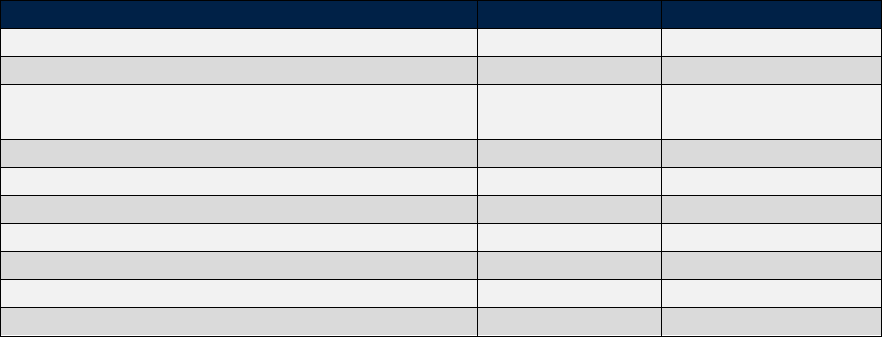
DBS Investment Management Guidance June 26, 2018
Department of Defense Page 24 of 54
Enterprise Architecture Plans
OEPs and other authoritative data sources are used to develop baseline architecture, target
architecture, and sequencing plan required by 44 U.S.C. § 3601.
2.4. General Investment Management Process Timeline
Table 2 depicts the sequence of events for Functional Strategy and OEP reviews. The DBC chair
will publish a schedule identifying specific dates for Functional Strategy input, PCA requests,
OEP reviews, etc. Functional area owners will initiate the process by submitting updated
Functional Strategies for DBC review with a focus upon strategic direction for the future budget
years. Upon completion of the Functional Strategy reviews, DoD Components will then develop
OEPs and submit them with a PCR by a date determined by the DBC chair. System data for
each DBS must be in DITPR, SNaP-IT, IBF-DAP, and DITIP. Certification approval for OEPs
will be documented in an IDM and budget adjustments, if any will be proposed to DCAPE and
Comptroller via the PPBE process.
Activity
Proponent
Date
Investment management guidance update issued
OCMO
February-March
Functional strategies available
PSAs, OCMO
February-March
SNaP-IT updated All organizations
Part of budget cycle
annually
Authoritative data sources updated
All organizations
June
OEPs submitted
All organizations
July
OEP analyses
CMOs, PSAs
February - August
DBC and CMO reviews
DBC and CMOs
July -August
IDM memorandums issued
DBC and CMOs
August - September
Program review (subsequent fiscal year’s budget)
DBC and CMOs
August- November
Budget Review
DBC and CMOs
December - January
Table 2 Investment Management Process Timeline
2.5. Out of Cycle Guidance
DoD organizations may require changes to previously approved OEPs; an Out of Cycle (OOC)
request is the vehicle for submission of these changes. Table 3 provides a summary required
component actions / business rules for OOC requests and activities.
An OOC request for review and certification of a covered DBS is required when a covered DBS
or associated funding has changed since previously reviewed, certified and approved during the
annual review cycle or when a covered DBS was not previously reviewed, certified or approved
during the same annual cycle. Dev / Mod OOC requests require approved documentation as
indicated by the DoDI 5000.75. If approved documentation is not available then it should be
submitted with the Dev / Mod OOC as a combined request for review and approval.

DBS Investment Management Guidance June 26, 2018
Department of Defense Page 25 of 54
Component Action
Required
Certification Owner Conditions for CMO / CMO of DoD Review
1. Submit OOC
for Review and
Certification
Request
Military Departments
(using DITIP)
Any increase in a system below $250M over the
period of the current FYDP and over the
established Military Departments threshold will
be reviewed for decision by Military Department
CMO in DITIP
Any increase in a system in excess of $250M over
the period of the current FYDP will be reviewed
for decision by CMO and the DCMO in DITIP
Fourth Estate
(using DITIP)
Any increase in a system will be reviewed for
decision by the DoD CMO in DITIP
2. Submit for
Notification
Only***
All (using DITPR) Removal of covered DBS from active Portfolio*
All (using DITIP) Any decrease in funding
Requests and Notifications are initiated using DITIPR, and DITIP. Application data updates to
DITIP, DITPR and IBF-DAP data are still required in all cases.
* A DBS may be removed from an active Portfolio either by archiving (e.g. retiring/erroneous entry)
or designating as a non DBS.
** As a business rule, an OOC request made in DITIP cannot mix positive and negative numbers.
All OOC requests with decreases should be processed first as a separate OOC request, followed by
increase(s) request.
***A signed PCR is not required for notification only submissions. Briefly explain the reason in the
DITIP comments field.
Table 3 – Required Component Actions for OOC Requests
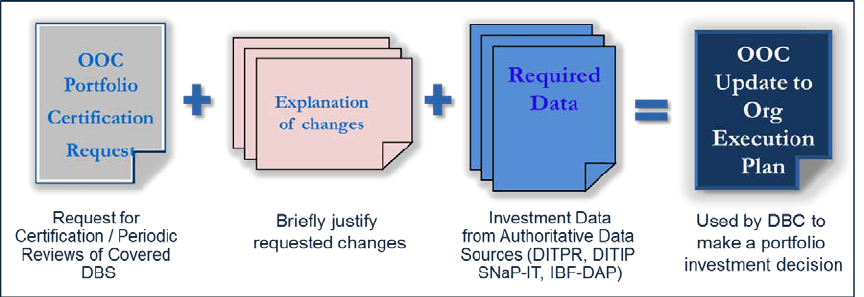
DBS Investment Management Guidance June 26, 2018
Department of Defense Page 26 of 54
OOC review and certification requests, as depicted in Figure 5, must contain:
• A signed PCR with either the appropriate PCA or CMO approval determinations
discussed in Section 2.2 of this guidance will be uploaded to DITIP with the request.
Additionally, an OOC PCR should identify proposed changes to the OEP using the PCR
Memorandum Template in Appendix F as a guide
• Appropriate data entry for the OOC request in DITIP, DITPR IBF-DAP (when changes
warrant) and SNaP-IT as the schedule permits.
The Fourth Estate Working Group will review Fourth Estate and priority DBS OOC requests on
a bi-weekly basis beginning in October. Submission of all Fourth Estate and priority DBS OOC
requests must be submitted no later than 15 August of the given year for certification. All other
Military Department OOC requests must be submitted and processed by the end of the FY.
Figure 5 Out of Cycle Organizational Execution Plan Construct

DBS Investment Management Guidance June 26, 2018
Department of Defense Page 27 of 54
3. Governance
The DBC provides unified direction and leadership through decision making to guide DoD’s
functional areas and organizations, drives alignment of activities with DoD’s strategic goals and
objectives to optimize DoD business operations, and promotes cost visibility. See Appendix A
and DBC Charter
12
for full description of responsibilities. The DBC leads governance efforts to
manage the IBF to include the DBC and future releases of BEA content. In particular, the DBC
concentrates on efforts to build a cost culture in DoD and to improve the focus on ROI. The key
governance bodies essential to the DBC process are comprised of the Military Department
CMOs, PCAs, PSAs, and the DBC itself.
3.1. Governance Bodies
Defense Business Council (DBC)
The DoD CMO and DoD CIO co-chair the DBC and review the Functional Strategies and DBS
based upon the review of portfolios. See DBC membership is listed in Table 4.
DBC Member Title
Co-Chairs
DoD CMO, DoD CIO
Principal
Members
Under Secretary of Defense for Acquisition, Technology and Logistics
Under Secretary of Defense for Policy
Under Secretary of Defense (Comptroller)/Chief Financial Officer
Under Secretary of Defense for Personnel and Readiness
Under Secretary of Defense for Intelligence
Director, Cost Assessment and Program Evaluation
Joint Staff
Chief, National Guard Bureau
Department of the Army, Chief Management Officer
Department of the Army, Chief Information Officer
Department of the Army, Acquisition Executive
12
http://dcmo.defense.gov/Governance/Defense-Business-Council/ linked in dates of charter

DBS Investment Management Guidance June 26, 2018
Department of Defense Page 28 of 54
DBC Member Title
Department of the Navy, Chief Management Officer
Department of the Navy, Chief Information Officer
Department of the Navy, Acquisition Executive
Department of the Air Force, Chief Management Officer
Department of the Air Force, Chief Information Officer
Department of the Air Force, Acquisition Executive
Advisor to Chair Office of the General Counsel
Table 4 - DBC Members
In the absence of the DoD CMO, the Assistant CMO will perform the functions of the co-chair.
OCMO will serve as Executive Secretary.
Chief Management Officer (CMO)
The CMO is responsible for review of the portfolio prior to the DBC. Military Department
CMOs review their portfolio for decision investments that are under $250M over the period of
the current FYDP. As the CMO for the Fourth Estate, the DoD CMO reviews the Fourth Estate
portfolios for decision. The CMOs provide results of their review and approval in a presentation
to the DBC which substantially eliminate redundant DBC reviews during the OOC certification
process.
Pre-Certification Authority (PCA)
The PCA is responsible for review of portfolios at the organizational level and for the statutory
assertions required such as BPR and BEA compliance. PCAs will make a recommendation to
the DBC in the PCR submitted to the DBC for review of the portfolios. This responsibility may
not be further delegated without notification to the DoD CMO and may not be delegated lower
than a General Officer or Senior Executive Service level equivalent.
3.2. DBC Governance Process Roles
The DBC plays a central governance role in the certification process of DBS investments. The
DBC process will follow these steps. A timeline for these steps are defined in the Investment
Management Process Timeline (Table 2)
• PSAs develop Functional Strategies: As discussed in 2.1, PSAs draft Functional
Strategies based on DBC guidance to prioritize activities of DoD organizations to support
DoD business priorities and system investments. The Functional Strategies articulate
each area’s strategic vision, goals, and targeted outcomes over the next three to five
years.
DBS Investment Management Guidance June 26, 2018
Department of Defense Page 29 of 54
• Working Groups conduct analysis (if necessary): The DBC Chair may establish
working groups, as required, to provide concentrated subject matter expertise and in-
depth analyses on complex, time-limited tasks to assist the DBC in executing its DBC
responsibilities. Led by a representative from a PSA or CMO with primary support from
OCMO and secondary / subject matter experts, working groups will assess specific
business issues such as those raised during the review of Functional Strategies and make
recommendations to the DBC based on quantitative analyses. To focus these efforts,
OCMO will draft working group project charters to identify primary objective, scope,
timeline, and team lead.
• DBC reviews Functional Strategies: When strategic priorities change and require
update, the PSAs will present their Functional Strategies to the DBC. PSA designees,
relevant domain experts, will participate in DBC discussions and make recommendations
on the draft Functional Strategies for DBC decision. Upon approval, the DBC will direct
DoD organizations to draft OEPs that identify and prioritize investments aligned with
these Functional Strategies.
• PCAs draft OEPs: As described in section 2.2, DoD organizations will draft OEPs to
align their DBS investments within their respective budgets. PCAs are responsible for
review of OEPs at the organizational level.
• CMOs review portfolio: CMOs perform portfolio reviews for the portfolio within their
respective organization and will review investments under $250M over the FYDP.
OCMO performs the portfolio review for the Fourth Estate exclusive of the Military
Departments.
• Pre-decisional review: PCAs will review their portfolios and make a recommendation
to the DBC in the PCR submitted to the DBC with the OEPs via the responsible CMO.
PSAs will review their portfolios and make a recommendation to the DBC. A workgroup
consisting of the chartered Fourth Estate Working Group and the Military Departments
provides a pre-decisional review and recommendation to the DBC based upon the OEP
and results performed by the responsible CMO. The workgroup will vet all
documentation and analysis prior to presentation to the DBC.
• DBC review portfolio: The responsible CMO representative will present the results of
their review to DBC.
• DoD CMO or Military Department CMO decision: Certify covered DBS decisions as
determined, and using relevant results of the DBC review.

DBS Investment Management Guidance June 26, 2018
Department of Defense Page 30 of 54
4. Roles and Responsibilities
4.1. Defense Business Council
DoD CMO and DoD CIO co-chair the DBC. See Appendix A and DBC Charter
13
for full
description of responsibilities
Defense Business Council Members
The DBC will review the Functional Strategies and portfolios presented by the respective PSAs
and CMOs, along with the analysis from chartered teams when required. The DBC is the focal
point for the investment review process using the IBF. PSAs are encouraged to establish and
document, in Functional Strategies, select and control criteria for CMOs to employ in evaluation
of their portfolios. Additionally, DBC members are responsible for making recommendations on
organizational DBS investment budgets if required and for providing certification
recommendations for covered DBS to the DBC Chair. These recommendations will focus on
details surrounding the planning, design, acquisition, development, deployment, operation,
maintenance, modernization and project cost benefits, and risks of all covered DBSs within the
portfolio. When the review process is complete, the DBC will make recommendations
concerning the certification of investments and any actions or conditions that may be required.
4.2. Chief Management Officer / Pre-Certification Authority
The PCA is the senior accountable official that is responsible for ensuring compliance with
investment review policies prescribed by the organization and this guidance. The approval
authority and PCA responsibilities are assigned to the CMO for each Military Department. For
the Fourth Estate, the CMO and approval authority is assigned to the DoD CMO. For the Fourth
Estate, the PCA is the organization head unless otherwise designated by the DoD CMO. See
Section 3 of this guidance for PCA delegation. The OEPs submitted to the DBC for the Fourth
Estate exclusive of the Military Departments must be via the Fourth Estate Working Group
chartered by the DBC.
PCAs will submit and present requests to the DBC with complete, current, and accurate
documentation within prescribed deadlines. Certification and periodic review requests must
comply with laws, regulations, and policy, such as the Clinger Cohen Act, BEA, BPR and
applicable documentation per the DoDI 5000.75. Validation of Fourth Estate pre-certification
will be documented via a PCR in the form of a PCA-issued memorandum (example found in
Appendix E), which will outline the portfolio’s composition, capabilities, and alignment to
13
http://dcmo.defense.gov/Governance/Defense-Business-Council/ linked in dates of charters
DBS Investment Management Guidance June 26, 2018
Department of Defense Page 31 of 54
applicable Business Strategies. Military Department pre-certification and approval must be
completed in DITIP.
The PCA is responsible for creation and use of select and control criteria used to manage
business processes and capital investments and for ensuring the incorporation of the CPIC
control and evaluation phase outcomes such as eliminating underperforming or low value
investments. The portfolio must reduce redundancy and be aligned to the strategic direction for
outcomes and initiatives within the Functional Strategies and the goals of the organization.
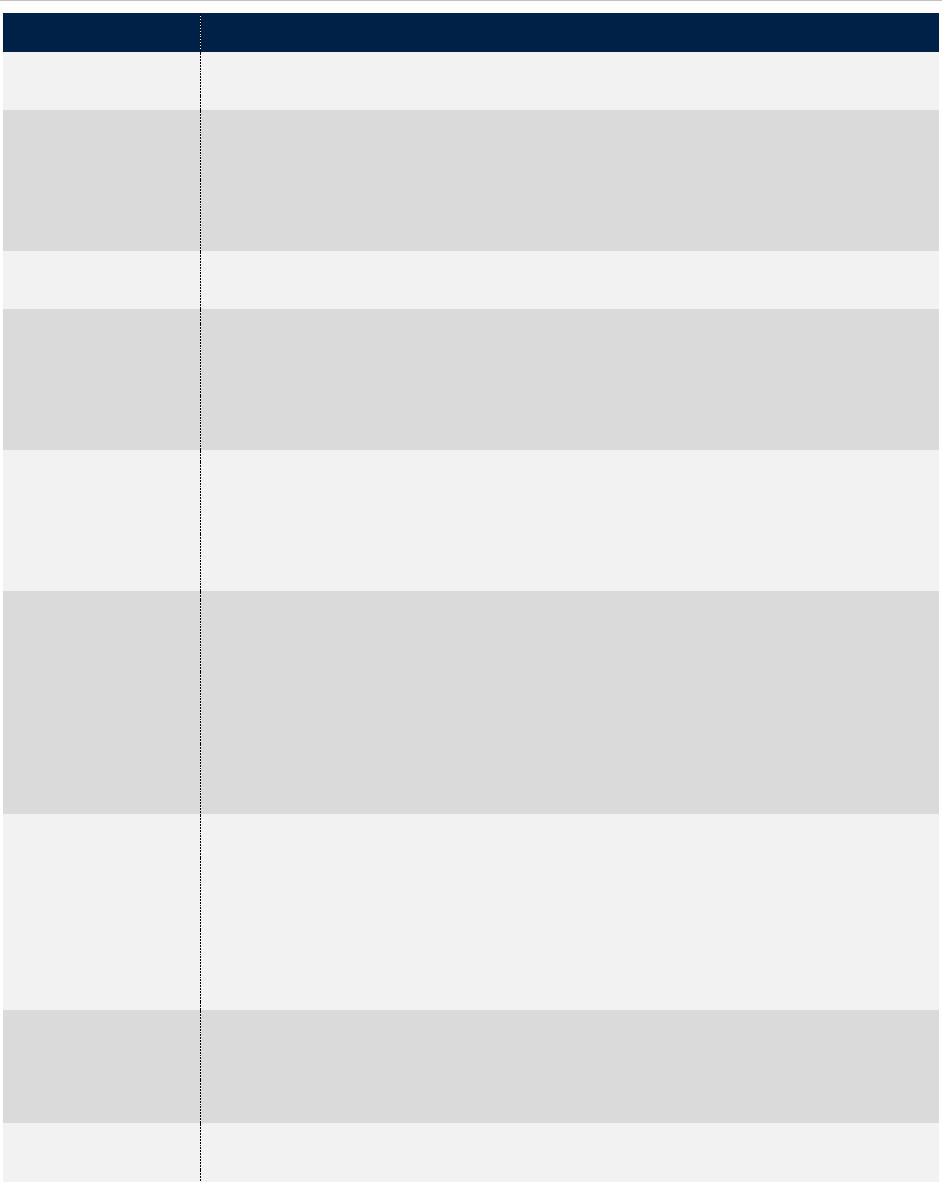
DBS Investment Management Guidance June 26, 2018
Department of Defense Page 33 of 54
Appendix B
Appendix B: Key Terms
Term
Definition
Fourth Estate
Refers to the other Defense organizations exclusive of the Military
Departments
Agency Strategic
Plan
The ASP is the DoD’s highest-level plan for improving DoD business
operations. It lays out the DoD’s priority business goals, objectives,
measures, and initiatives. The ASP informs and is informed by, processes
and activities that support the execution of the DoD’s business strategy.
The DOD CMO oversees the execution of this strategy.
Alignment
Linkage to higher-level goals and strategies. Also, consonance and
integration across related activities.
Authoritative
Data Sources
A recognized or official data production source with a designated mission
statement or source / product to publish reliable and accurate data for
subsequent use by customers. An authoritative data source may be the
functional combination of multiple, separate data sources (see Table 1 for
DITPR, SNaP-IT, IBF-DAP, and DITIP).
Baseline
An “as is” reading of all measures constitutes a baseline (included in the
Functional Strategy). Targets are set against that baseline. Periodic
measures are captured and compared to the baseline to assess
performance, financial benefits, and non-financial benefits or look at
results of changes. A baseline can also refer to an architecture “as is.”
Business
Enterprise
Architecture
In accordance with 10 U.S.C. § 2222(c), the BEA is the enterprise
architecture developed and maintained as a blueprint to guide the
development of integrated business processes within the DoD. It must be
sufficiently defined to effectively guide implementation of interoperable
defense business system solutions and consistent with the policies and
procedures established by the Director of the Office of Management and
Budget. The BEA is the DoD’s blueprint for improving DoD business
operations and the reference model for DBC certification.
Business Process
Reengineering
Business Process Reengineering (BPR) is a logical methodology for
assessing process weaknesses, identifying gaps, and implementing
opportunities to streamline and improve the processes to create a solid
foundation for success in changes to the full spectrum of operations. BPR
seeks to ensure that the business processes to be supported by a Defense
Business System is as streamlined and efficient as possible. All DBSs
must be mapped to appropriate business processes during BPR.
Capital Planning
and Investment
Control
CPIC is an IT portfolio-driven management process for ongoing
identification, selection, control, and evaluation of investments. This
process attempts to link budget activities and agency strategic priorities
with achieving specific IT program modernization outcomes.
Core
An enduring system with a sunset date greater than 36 months from the
start of the fiscal year. For consistency, core status in DITPR is

DBS Investment Management Guidance June 26, 2018
Department of Defense Page 34 of 54
Appendix B
Term
Definition
calculated the same for both covered and non-covered as more than 36
months.
14
Covered and
Priority Defense
Business System
Program
Covered DBS means a DBS that is expected to have a total amount of
budget authority, over the period of the current future-years defense
program submitted to Congress under section 221 of title 10, in excess of
$50,000,000 (10 U.S.C. § 2222 (j)(2)).
Priority Defense Business System Program means a DBS that is expected
to have a total amount of budget authority over the period of the current
future-years defense program submitted to Congress under section 221 of
this title in excess of $250,000,000; or designated by the DOD CMO as a
priority DBS, based on specific program analyses of factors including
complexity, scope and technical risk and after notification to Congress of
such designation (10 U.S.C. § 2222 (j)(2)).
For the purposes of this guidance, the term ‘covered DBS’ includes those
DBSs greater than the minimum thresholds defined in 10 U.S.C. § 2222
stated above as well as the thresholds established by the CMOs.
Fundamentally, all DBSs greater than the internal thresholds will be part
of the review and certification process described in this guidance.
Defense Business
Council
The senior governance forum for the effective management of the DoD
Business Mission Area, to include performing the roles and
responsibilities of 10 U.S.C. § 2222 (f), providing portfolio analysis and
process integration, and implement the Secretary’s Management Agenda,
for vetting issues related to management, improvement of defense
business operations.
Defense Business
System
An information system that is operated by, for or on behalf of the DoD,
including a financial system, a financial data feeder system, a contracting
system, a logistics system, a planning and budgeting system, an
installations management system, a human resources management system
or a training and readiness system. The term does not include a national
security system; or an information system used exclusively by and within
the defense commissary system or the exchange system or other
instrumentality of the DoD conducted for the morale, welfare and
recreation of members of the armed forces using nonappropriated funds
(10 U.S.C. § 2222 (j)(1)).
14
DITPR formula is "IF Lifecycle End Date <= 36 months from 09/30/CURRENTYEAR then = Legacy."
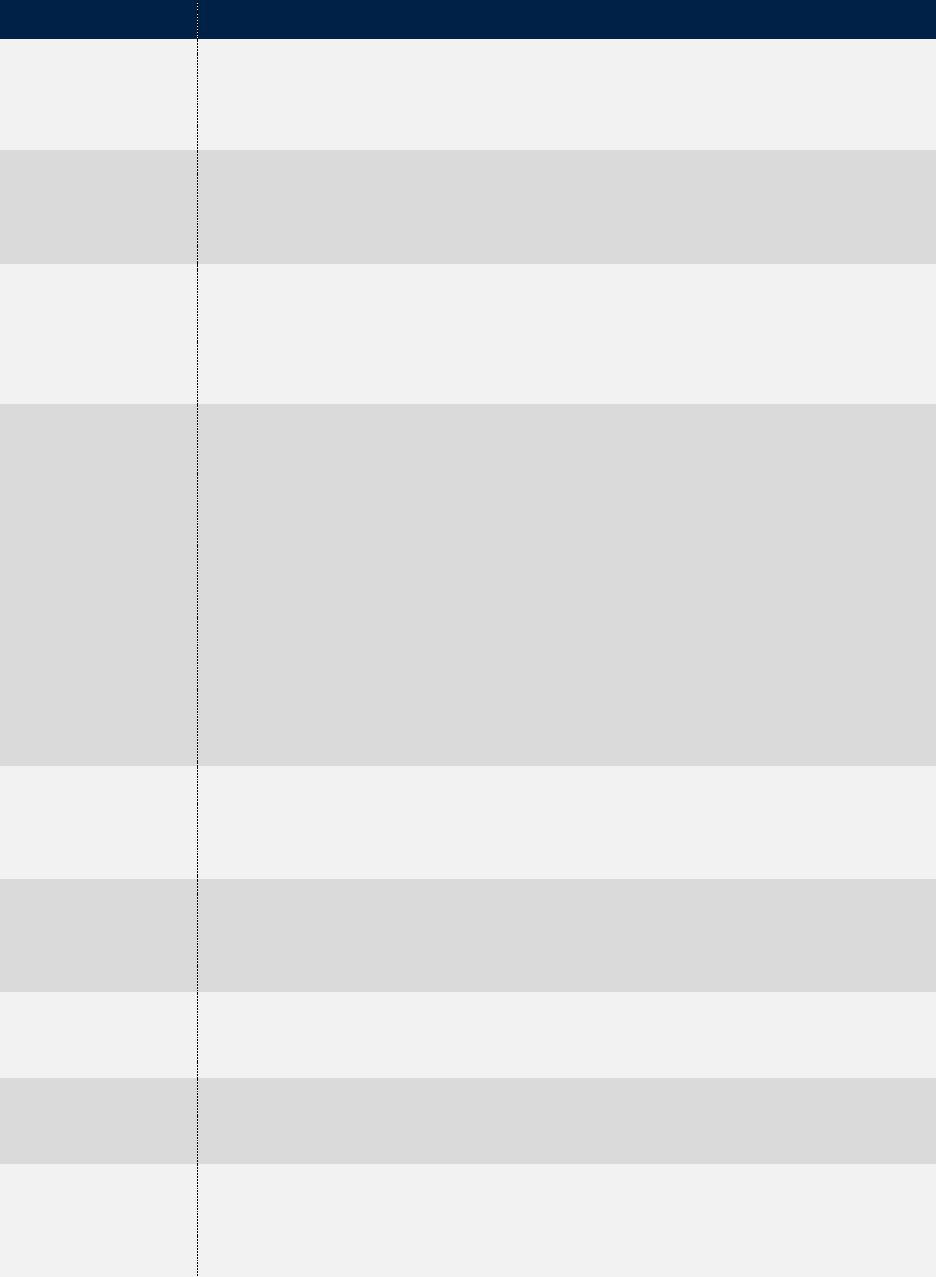
DBS Investment Management Guidance June 26, 2018
Department of Defense Page 35 of 54
Appendix B
Term
Definition
Chief
Management
Officer
The DOD CMO is the co-chair of the Defense Business Council (DBC),
the approval official for covered DBS in the Fourth Estate and all priority
DBS, and the developer and maintainer of the BEA.
DoD Components
Office of the Secretary of Defense, the Military Departments, the Joint
Staff, the Combatant Commands, the Office of the Inspector General of
the DoD, the Defense Agencies, the DoD Field Activities and all other
organizational entities of the DoD.
End-to-End
End-to-End (E2E) business models of critical processes and associated
activities defined in the Business Enterprise Architecture (BEA) such as
Hire-to-Retire and Procure to Pay lifecycle models. E2Es comprise a
framework used to understand the DoD business environment and evolve
the BEA.
Functional
Strategy
Functional Strategies are developed by the PSA and describe business
functions, business outcomes, measures, and targets. Functional
Strategies will be used to drive BEA content, which is the DoD’s
blueprint for improving DoD business operations and the reference model
for DBC certification. The Functional Strategy is the core document that
creates the unique business position of the organization and is supported
by the activities that it plans to achieve. It prioritizes and identifies the
enterprise’s pressing needs while providing tactical strategic direction for
a defined business area. It enables outcome-driven investment decisions
that enhance the business operations within a functional area in
synchronization with other business areas. Functional Strategies must
align with the ASP and will also help to refine and enhance future
versions of the ASP.
Information
System
The term "information system" means a discrete set of information
resources organized for the collection, processing, maintenance, use,
sharing, dissemination or disposition of information (source section 3502
title 44)
Information
Technology
Investment
Management
GAO developed the ITIM Framework to provide a common framework
for discussing and assessing IT capital planning and investment
management practices at federal agencies. ITIM is also intended to serve
as a guide to sound IT investment management practices.
Integrated
Business
Framework
Functional Strategies coupled with OEPs will comprise the Integrated
Business Framework (See Figure 1).
Investment
Decision
Memorandum
The memorandum signed by the DOD CMO or the Military Department
CMO that documents the certification decision of the portfolio.
Legacy
A system with a sunset date within 36 months from the start of the fiscal
year. For consistency, legacy status in DITPR is calculated the same for
both covered and non-covered as a life cycle end date less than or equal to
36 months. Legacy DBSs are not required to assess or assert compliance
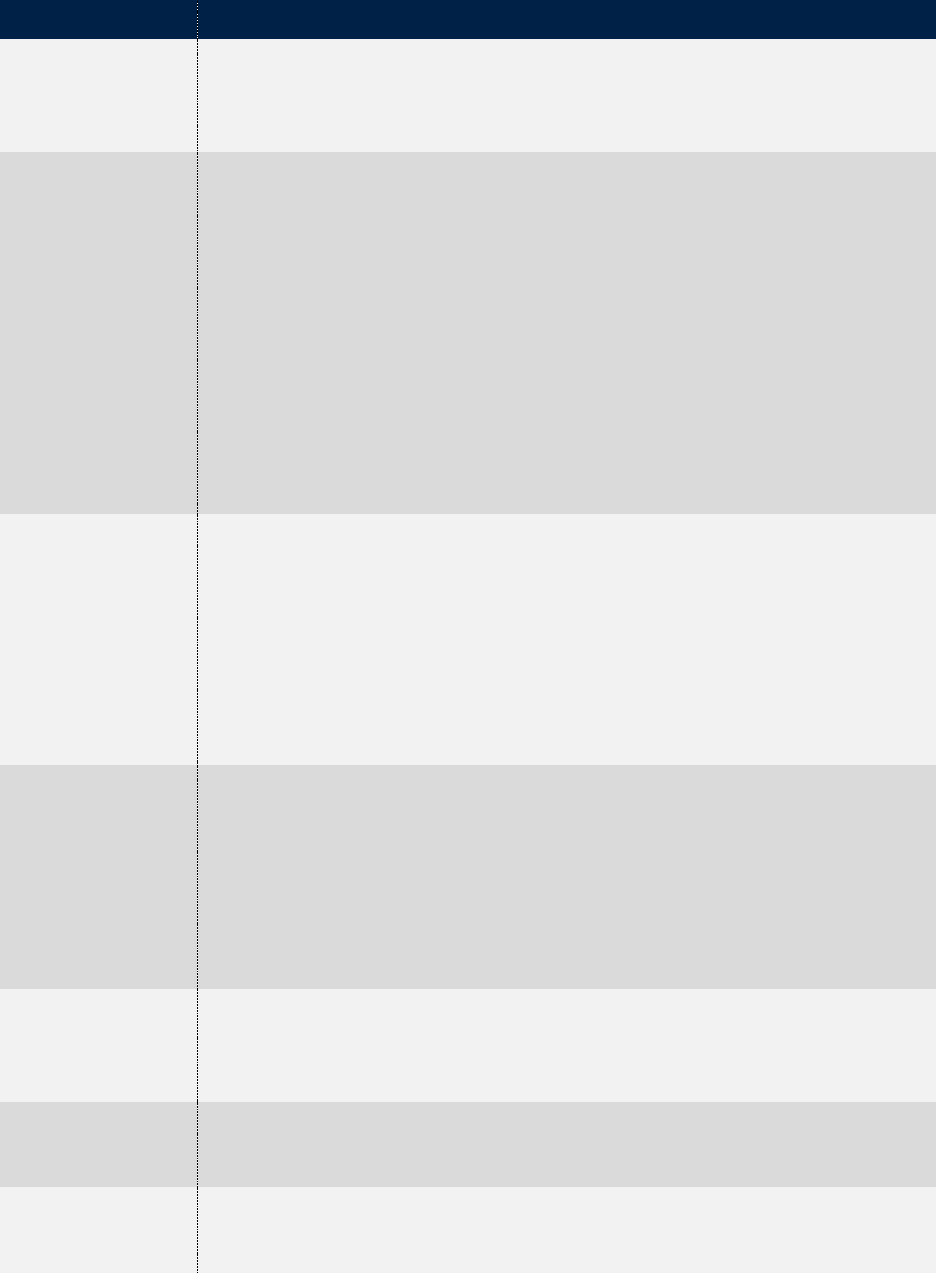
DBS Investment Management Guidance June 26, 2018
Department of Defense Page 36 of 54
Appendix B
Term
Definition
with applicable BEA requirements, but they are required to perform
mappings in IBF-DAP to applicable BEA Operational Activities,
Business Capabilities, Processes, System Functions, and E2Es. Legacy
systems are not allowed to obligate modernization dollars.
Measures
A measure is a standard or basis for comparison – an assessment using
quantitative data (e.g. cost, production, defect, and time) or sometimes
qualitative data, tracked incrementally over a specified period. Measures
can assess performance, financial benefits, and non-financial benefits or
look at results of changes made from implementation of new policy or
practice.
Each measure should be explained (as appropriate) and linked to an
outcome. An appropriate measure demonstrates the viability of a desired
solution. Measures should reflect consideration of cost to measure and
the estimated value for that measurement. An “as is” reading of all
measures should be included in the Functional Strategy as a baseline;
targets against that baseline and rationale for the targets should complete
the picture.
Operations and
Support (O&S)
Phase
The purpose of the O&S phase is to execute the Product Support Strategy,
satisfy materiel readiness and operational performance requirements, and
sustain the system over its life cycle (to include disposal). This phase has
two major efforts: Life Cycle Sustainment and Disposal. The Life Cycle
Sustainment effort overlaps the Full-Rate Production (FRP) or Full
Deployment part of the P&D phase. At the end of its useful life, a system
will be demilitarized and disposed of in accordance with all legal and
regulatory requirements and policy relating to safety (including
explosives safety), security, and the environment. (DAU Glossary)
Organizational
Execution Plan
The OEP is the means through which the DoD Components propose how
they will deliver the DoD’s business priorities. A completed plan will
demonstrate how, through sound investment management, a DoD
Component’s streamlined portfolio of systems will support the business
areas and sub-functions contained within the BMAs. The plan is divided
into sections that address each Functional Strategy. The plan is intended
to be the assembly of business system investment requests from which the
DBC certifies.
Planning,
Programming,
Budgeting and
Execution
The Planning, Programming, Budgeting, and Execution (PPBE) process is
how the DoD allocates its resources.
Portfolio
A portfolio consists of all of the defense business system information
technology investments belonging to an organization. A subdivision of a
DBS portfolio for the purpose of this guidance is called a chapter.
Sunset Date
Systems are sunset (or terminated) when they do not contribute to the
mission, are being replaced by other capabilities, do not fit the approved
“To-Be” integrated architectures, or are not programmatically viable).

DBS Investment Management Guidance June 26, 2018
Department of Defense Page 37 of 54
Appendix B
Term
Definition
Terminated systems shall have a firm date when their funding ends).
(5000.02 E4)
The sunset date of a system is tracked in DITPR by the Operations and
Support (O&S) Lifecycle Phase end date. DITPR also tracks the date a
system was archived however this is a system-generated date that only
marks the date on which the DITPR record was archived by the user and
not the sunset date.
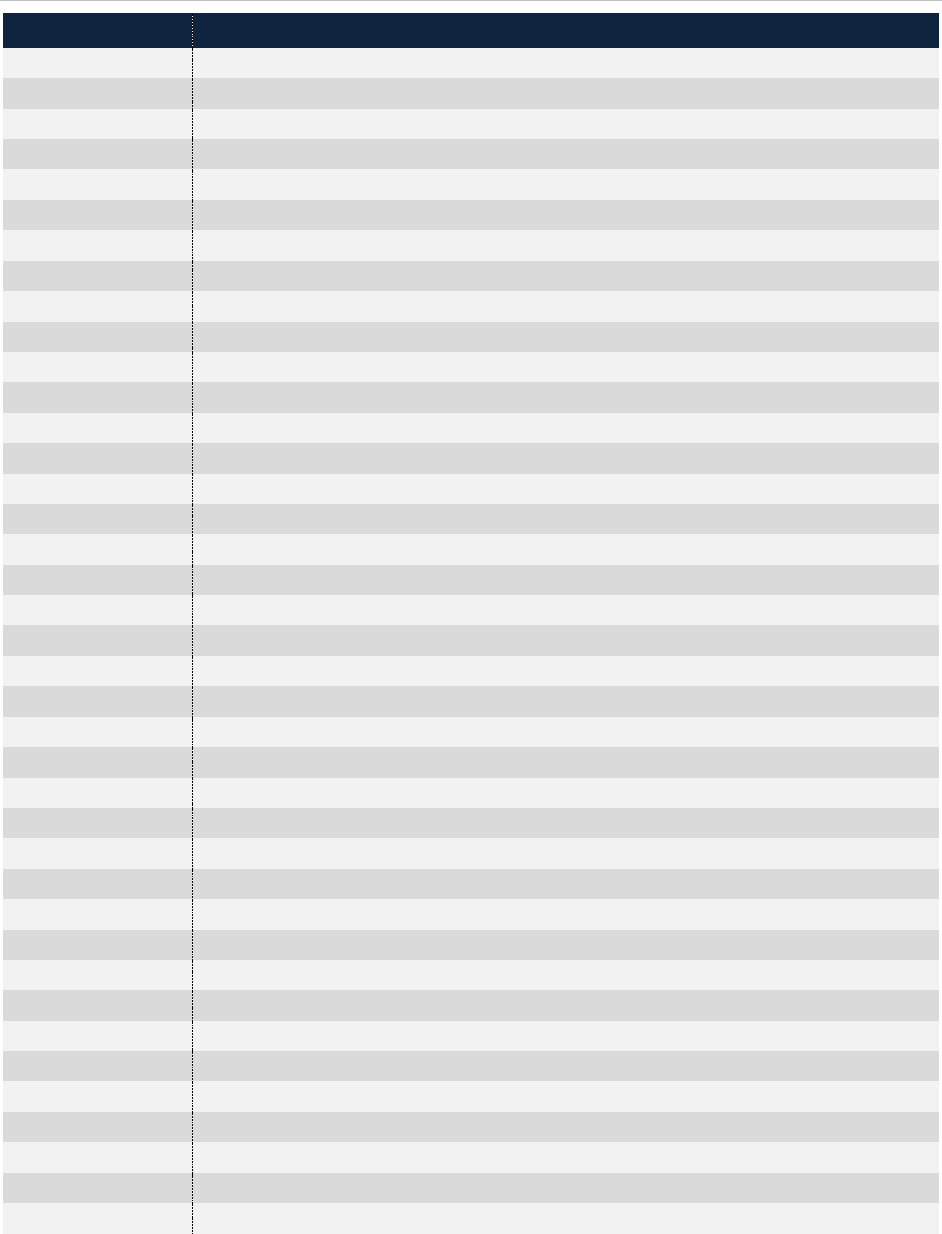
DBS Investment Management Guidance June 26, 2018
Department of Defense Page 38 of 54
Appendix C
Appendix C: Acronyms and Abbreviations
Acronym
Definition
ASP
Agency Strategic Plan
A&S
Acquisition and Sustainment
BCAC
Business Capability Acquisition Cycle
BEA
Business Enterprise Architecture
BPM
Business Process Management
BPR
Business Process Reengineering
CMO
Chief Management Officer
COTS
Commercial off the Shelf
CPIC
Capital Planning and Investment Control
CS
Current Services
DBC
Defense Business Council
DBS
Defense Business System
DCAPE
Director, Cost Assessment Program Evaluation
DoD CMO
DoD Chief Management Officer
Dev/Mod or DM
Development and Modernization
DITIP
DoD Information Technology Investment Portal
DITPR
DoD Information Technology Portfolio Repository
DoD
Department of Defense
E2E
End-to-End
ERP
Enterprise Resource Planning
FTE
Full-Time Equivalent
FY
Fiscal Year
FYDP
Future Years Defense Program
GAO
Government Accountability Office
IBF-DAP
Integrated Business Framework – Data Alignment Portal
IDM
Investment Decision Memorandum
IRB
Investment Review Board
IT
Information Technology
ITIM
Information Technology Investment Management
JIE
Joint Information Environment
MilDep
Military Department
NDAA
National Defense Authorization Act
NSS
National Security System
OCMO
Office of the Chief Management Officer
ODO
Other Defense Organizations
OEP
Organizational Execution Plan
OOC
Out of Cycle
OSD
Office of the Secretary of Defense
PCA
Pre-Certification Authority

DBS Investment Management Guidance June 26, 2018
Department of Defense Page 39 of 54
Appendix C
Acronym
Definition
PCR
Portfolio Certification Request
PPBE
Planning, Programming, Budgeting and Execution
PSA
Principal Staff Assistant
ROI
Return on Investment
SNaP-IT
Select and Native Programming Data Input Systems for IT
U.S.C
United States Code
USD
Under Secretary of Defense

DBS Investment Management Guidance June 26, 2018
Department of Defense Page 40 of 54
Appendix D
Appendix D: Integrated Business Framework Tools
The Integrated Business Framework tools provide automation support to collect structured
information relative to business strategies and portfolios.
The Functional Strategy module enables consistent definition and alignment of strategic business
objectives and initiatives. The module provides the alignment points for portfolio data which
can then provide linkage from strategic objectives to implementation decisions.
The unstructured OEP information previously submitted via spreadsheets and presentations is
captured using the OEP module of the IBF tool. The OEP module allows for collection of data
required for OEP submissions not contained within the other authoritative data sources (e.g.,
DITPR, SNaP-IT) and avoids duplicate data entry. The IBF tool is also used to perform BEA
assessments in its BEA module.
The IBF tools are accessed from the internal BEA portal home page, https://bea-
etools.osd.mil/ee/. Documentation for the tools and specific data information collected by the
tool is available on the BEA portal.
Figure 6 - Integrated Business Framework tools homepage

DBS Investment Management Guidance June 26, 2018
Department of Defense Page 41 of 54
Appendix F
Appendix E: Organizational Execution Plan Portfolio
Certification Request Memorandum – Sample
DEFENSE ORGANIZATION
3000 DEFENSE PENTAGON
WASHINGTON, DC 20301-3000
MEMORANDUM FOR
INVESTMENT REVIEW BOARD / DEFENSE BUSINESS
COUNCIL CHAIRPERSON
SUBJECT: Pre-Certification Authority Portfolio Certification Request for [Enter
Organizational Execution Plan Name] Organizational Execution Plan
Request review and certification of covered defense business systems (DBS) investments with
funding amounts of [Total Amount: Break out the exact dollar amount ($M) request by
Fiscal Year and by development/modernization and current services, to three decimal
places] as detailed within the Defense Information Technology Investment Portal (DITIP). This
investment in the portfolio is required to [Summarize how it will improve performance,
Warfighter support, satisfy a mandate, law, regulation or DoD policy, or provide a critical
capability].
I verify the DBS(s) in the Organizational Execution Plan (OEP) are included in the Defense
Information Technology Portfolio Repository (DITPR), the DITIP and the Integrated Business
Framework – Data Alignment Portal (IBF-DAP) and the data is complete and accurate. The
budget data in the Select & Native Programming Data Input System for Information Technology
(SNaP-IT) is verified to be complete and accurate and risk-adjusted return on investment criteria
were applied for each applicable DBS (s) modernization.
I reviewed the covered DBS in this OEP and determined each program meets the conditions
identified under 10 U.S.C. § 2222(g). My determination(s) are identified in DITIP.
I reviewed the status of the conditions applied to my covered DBS(s) during previous
certification cycle(s) in IBF SharePoint Portal and their status is current.
I recommend approval of this request. All required documentation has been forwarded for your
review. My point of contact for questions about this submission is [Full Name] who may be
reached at [Phone Number] or email at [Email Address].
Pre-Certification Authority

DBS Investment Management Guidance June 26, 2018
Department of Defense Page 42 of 54
Appendix G
Appendix F: Out-of-Cycle Portfolio Certification Request
Memorandum – Sample
DEFENSE ORGANIZATION
3000 DEFENSE PENTAGON
WASHINGTON, DC 20301-3000
MEMORANDUM FOR
INVESTMENT REVIEW BOARD / DEFENSE BUSINESS
COUNCIL CHAIRPERSON
SUBJECT: Pre-Certification Authority Portfolio Certification Request for [Enter
Organizational Execution Plan Name] Organizational Execution Plan Out-of-Cycle Change
Request review and certification of a(n) [increase/decrease] of [Total Amount: Break out the
exact dollar amount ($M) request by Fiscal Year and by development/modernization and
current services, to three decimal places] to covered defense business system(s) (DBS)
investments as detailed within the Defense Information Technology Investment Portal. This
[increase/decrease] in the portfolio is required to [Summarize how it will improve
performance, Warfighter support, satisfy a mandate, law, regulation or DoD policy or
provide a critical capability].
I verify the covered DBS(s) in the Organizational Execution Plan (OEP) Out-of-Cycle (OOC)
Change are included in the Defense Information Technology Portfolio Repository (DITPR), the
Defense Information Technology Investment Portal (DITIP) and the Integrated Business
Framework – Data Alignment Portal (IBF-DAP) and the data is complete and accurate. The
budget data in the Select & Native Programming Data Input System for Information Technology
(SNaP-IT) is verified to be complete and accurate and risk-adjusted return on investment criteria
were applied for each applicable covered DBS (s) modernization.
I reviewed the covered DBS(s) programs in this OEP OOC and determined each program meets
the conditions identified under 10 U.S.C. § 2222(g). My determination(s) are identified in
DITIP.
I reviewed the status of the conditions applied to my covered DBS(s) during previous
certification cycle(s) in IBF SharePoint Portal and their status is current.
I recommend approval of this request. All required documentation has been forwarded for your
review. My point of contact for questions about this submission is [Full Name] who may be
reached at [Phone Number] or email at [Email Address].
Pre-Certification Authority

DBS Investment Management Guidance June 26, 2018
Department of Defense Page 43 of 54
Appendix G
Appendix G: Mandatory Data Elements
DITPR Data Elements
DITPR Data Element
Description (Sample Data)
DITPR TAB
System Name
Full, un-abbreviated name of the
system.
GENERAL INFO – Basic
System Information
The SNaP-IT title and DITPR
system name value must match.
Acronym
A shortened or commonly used
name or abbreviation (upper case)
for this entry
The SNaP-IT acronym and DITPR
value must match.
GENERAL INFO – Basic
System Information
DITPR ID Number
GENERAL INFO – Basic
System Information
Unique Investment
Identifier (UII) from
SNaP-IT/DITIP
Number
Only one DBS can be matched
with a UII or an allowed exception
code may be used. Exception
codes allowed are 9991, 9992,
9993, 9994, 9995, 9996, 9997, and
9998, however see notes at the end
of this Appendix for the use of
code 9998.
GENERAL INFO – Basic
System Information
Description Complete description of system
GENERAL INFO – Basic
System Information
System
Component(Owner)
DBS System Owner
GENERAL INFO – Basic
System Information
DBS
Yes, which signifies the system
meets the definition of a defense
business system.
GENERAL INFO – Basic
System Information
System Association
Relationship Type
Identification of association
between individual systems, Other
or Parent-Child. O - Other
(default), C – Child, if applicable
GENERAL INFO –
Associated Systems
POC
Includes Point of Contact
Information (POC Name, email
and telephone)
• Program Manager
• PCA POC
• MDA, as applicable
POC
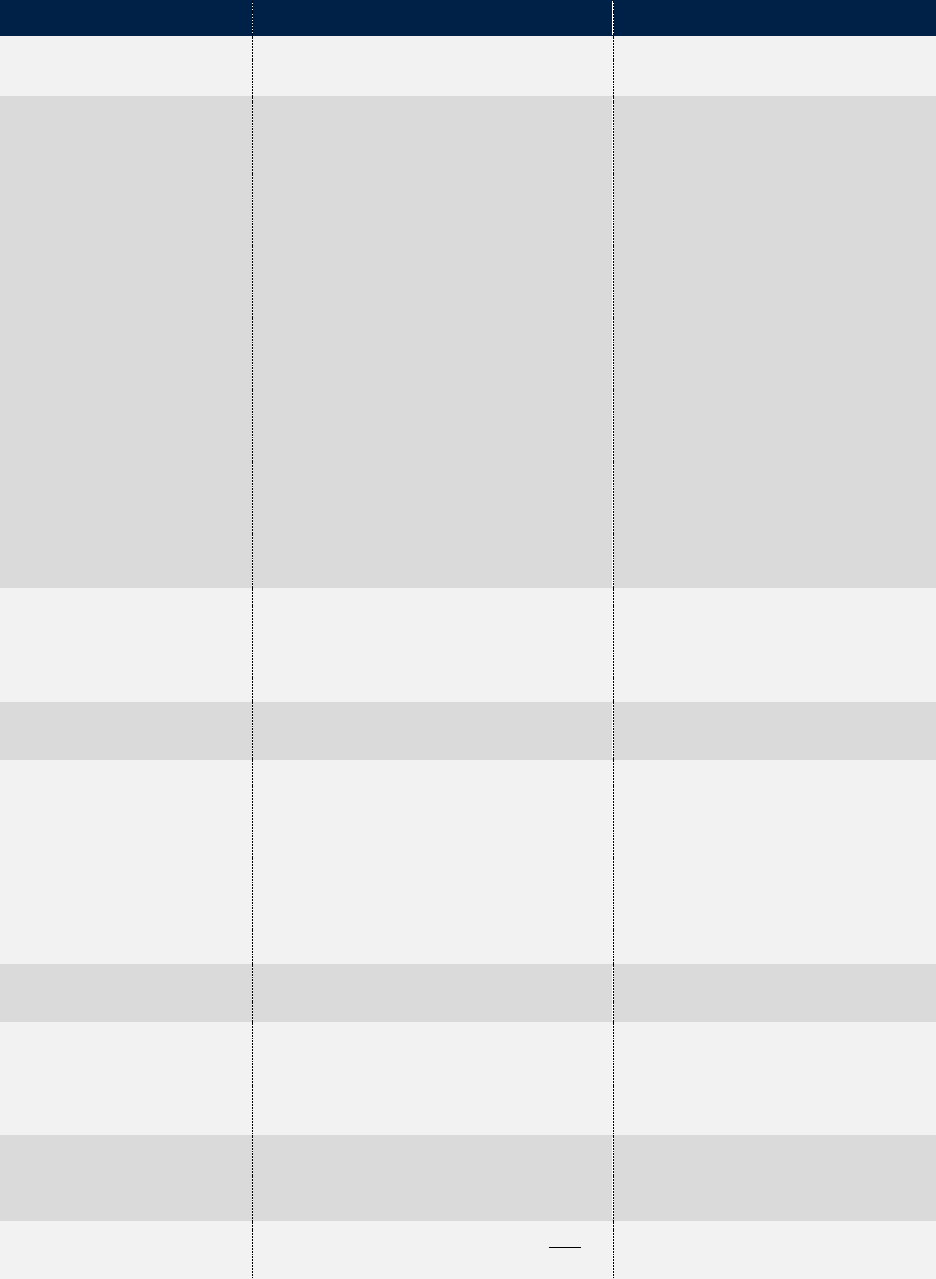
DBS Investment Management Guidance June 26, 2018
Department of Defense Page 44 of 54
Appendix G
DITPR Data Element
Description (Sample Data)
DITPR TAB
Total Users
Number of users (e.g. 0-250, 250-
500, etc.)
GENERAL INFO – Basic
System Information
Business Function
(Business Area)
As best describes system role:
• Financial Management
• Acquisition
• Defense Security
Enterprise
• Logistics &Materiel
Readiness
• Installations &
Environment
• Human Resources
Management
• Defense Health
• Security Cooperation
• Enterprise IT Infrastructure
• Planning and budgeting
• Training and Readiness
• Other
GENERAL INFO – Basic
System Information
Transition Plan State
Not user defined - Automatically
assigned based on lifecycle end
date and definition of core and
legacy as implemented in DITPR
GENERAL INFO – Basic
System Information
Use Modified COTS? Yes or No
GENERAL INFO – Basic
System Information
Lifecycle Phase
• Material Solution Analysis
• Technology Development
• Engineering &
Manufacturing
Development
• Production & Deployment
• Operations & Support
GENERAL INFO – Basic
System Information
Lifecycle Phase: Start
Date
Production & Deployment is also
the deployment date
GENERAL INFO – Basic
System Information
Lifecycle Phase: End
Date
For legacy systems, Operations &
Support is also the
Sunset/Retirement/ Decommission
Termination Date
GENERAL INFO – Basic
System Information
Number of Interfaces
to Other Systems
Specific number of interfaces to
external systems. Select from
drop-down list of range of values.
GENERAL INFO – Basic
System Information
Using Components
Components/Commands that use
the DBS or will be using it in the
GENERAL INFO – Basic
System Information
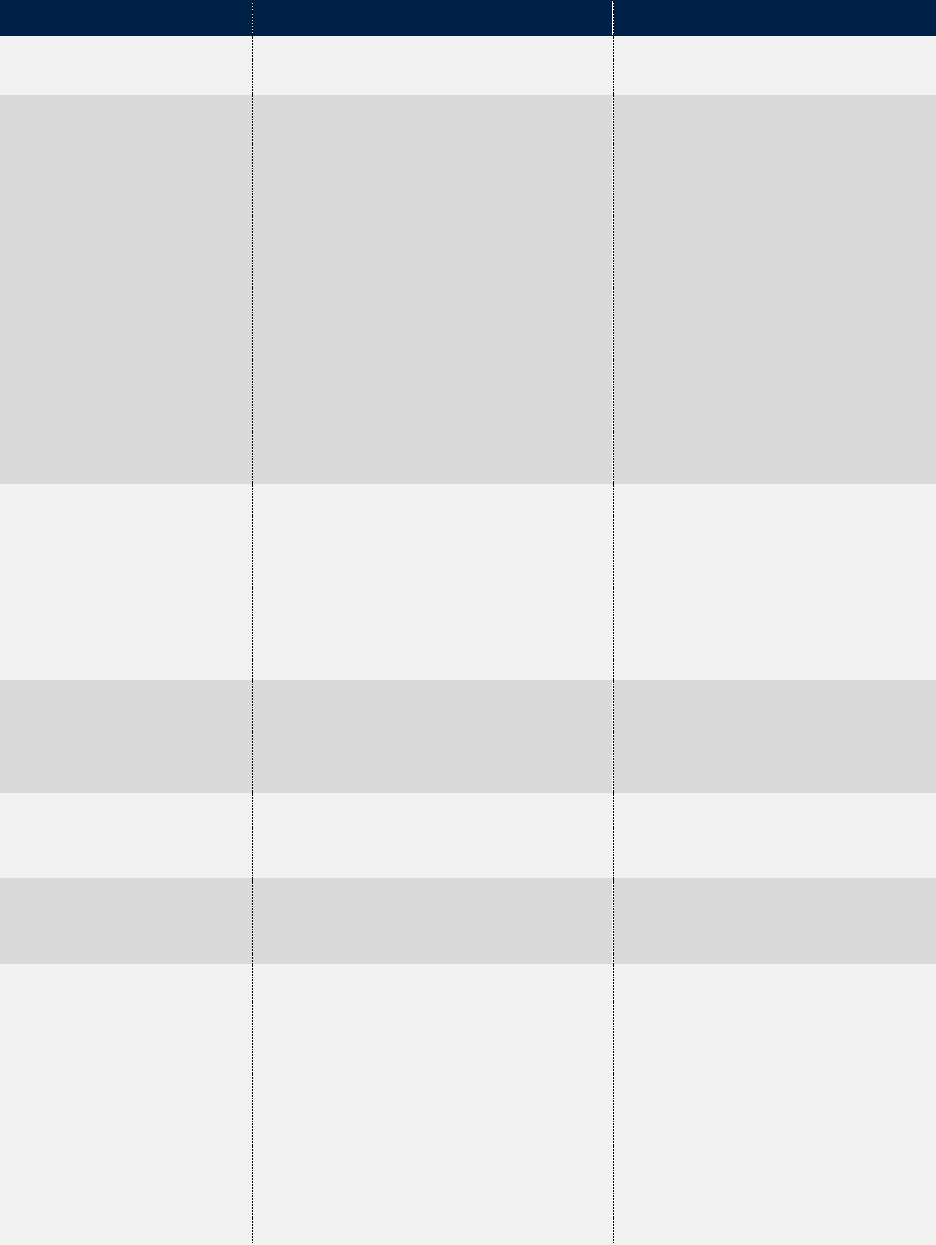
DBS Investment Management Guidance June 26, 2018
Department of Defense Page 45 of 54
Appendix G
DITPR Data Element
Description (Sample Data)
DITPR TAB
future (Select all that apply from
list, if applicable)
Full / Partial Migration
This field indicates if the legacy
migration is a full or partial
migration. If the system is
migrating only part of the
functionality and / or some of its
users to the target system, the
migration is partial. Note: This
field is used to produce the
sequencing plans. PCAs should
not classify a DBS as legacy if the
plan is to migrate partial capability
but retain the remainder of the
capability for more than 36
months.
GENERAL INFO – Basic
System Information
Migration Comment
This field is used if the Full/Partial
Migration is set to 'Partial' or if no
termination date is specified. It is
used to describe the functionality
or users that are not migrating to
the target or to describe why the
system is not terminating.
GENERAL INFO – Basic
System Information
Target System
Identifier
This is the DITPR ID for the target
system to replace some or all of
the functions and users of the
legacy system.
GENERAL INFO – Basic
System Information
Migration End Date
The date in YYYYMMDD format
that the migration to the specified
target is to be complete.
GENERAL INFO – Basic
System Information
Standard Financial
Information Structure
(SFIS) compliance data
SFIS data fields, as applicable. SFIS
Current and, as
applicable, Planned
Primary Hosting
Environment, DoD
Unique ID
Use DoD Enterprise IT
Infrastructure for processing,
storage and transport:
• Migrate from system-
specific IT infrastructure to
Enterprise IT infrastructure
at the first opportunity
(e.g., with appropriate
business case in
conjunction with a
INFRA

DBS Investment Management Guidance June 26, 2018
Department of Defense Page 46 of 54
Appendix G
DITPR Data Element
Description (Sample Data)
DITPR TAB
technology refresh or
contract expiration)
• Comply with all DoD
infrastructure requirements
on stand-alone / program-
specific infrastructure prior
to migration to Enterprise
IT Infrastructure
• If a DBS has a requirement
that can only be satisfied
by using commercial or
mission partner IT
infrastructure, these
connections must follow
the GIG waiver process
PK-Enabled for
Authentication
PK Information Assurance (IA)
PK-Enabled Reason
PK
IA
If not PK-enabled and not required
by DoD policy, provide Reason
System is not required to be PK-
Enabled
If not PK-Enabled but is required
to be PK-Enabled by DoD policy,
provide PK-Enable Expected Date
and Waiver information
IA
HBSS-Enabled, HBSS
Components
Implemented, HBSS
Not Required
Explanation, HBSS
Full Compliance Date
HBSS IA
IPv-6 Enabled
IPv6
IA
Identifiable Info
Personally Identifiable
Information (PII)
PIA/PA COMPLIANCE
Contains record data Records management fields
COMPLIANCE RECORDS
MANAGEMENT
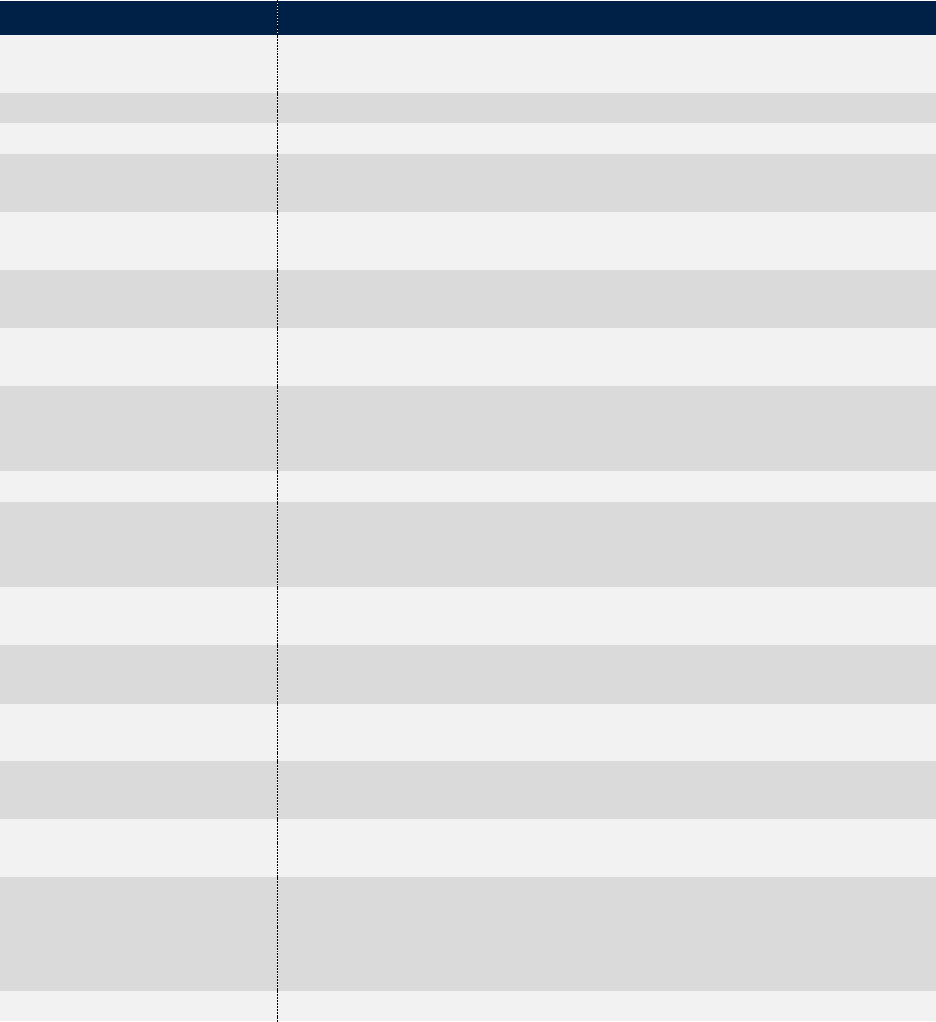
DBS Investment Management Guidance June 26, 2018
Department of Defense Page 47 of 54
Appendix G
SNaP-IT Data Elements
SNaP-IT Data Element
Description (Sample Data)
Unique Investment
Identifier (UII)
The Unique Identifier of an IT Investment. Must align 1:1 to the
SNaP-IT Budget UII to the system in DITPR.
Title
The SNaP-IT title and DITPR system name value must match.
Acronym
The SNaP-IT acronym and DITPR acronym value must match.
Budget ID
Indicates the actual budget submission of the resource record
(e.g., FY13PB, FY14PB etc.).
Resources Organization
Code
The DoD Financial Management Structure (FMS) component
codes (also used as Program Element (PE) suffix).
Resource Organization
The organization acronym that corresponds to the Resources
Organization Code.
Resource Bureau
Identifies the Bureau of the resource record (Army, Navy, Air
Force, or Defense-wide).
Funding Source
Identifies the resource record as DoD base budget or Other
Contingency Operations (OCO). All non-appropriated funds
systems should be base budget.
Treasury Code
Identifies the Treasury Code for the resource record.
BA Code
Identifies the Budget Activity code for the resource record.
For Nonappropriated Funds Instrumentality (NAFI), this is not
applicable.
BA Title
The BA title that corresponds to the BA Code.
For NAFI, this is not applicable.
PE
Identifies the Program Element for the resource record.
For NAFI, this is not applicable.
PE Title
The PE title that corresponds to the PE Code.
For NAFI, this is not applicable.
BLI Code
Identifies the Budget Line Item code for the resource record.
For NAFI, this is not applicable.
BLI Title
The BLI title that corresponds to the BLI Code.
For NAFI, this is not applicable.
Seven columns of data
elements: PY, CY, BY,
BY+1, BY+2, BY+3,
BY+4
Number in the FYDP Budget:
Required for Life-cycle Cost (LCC)
DM/CS
Identifies the resource record as Dev / Mod or CS budget
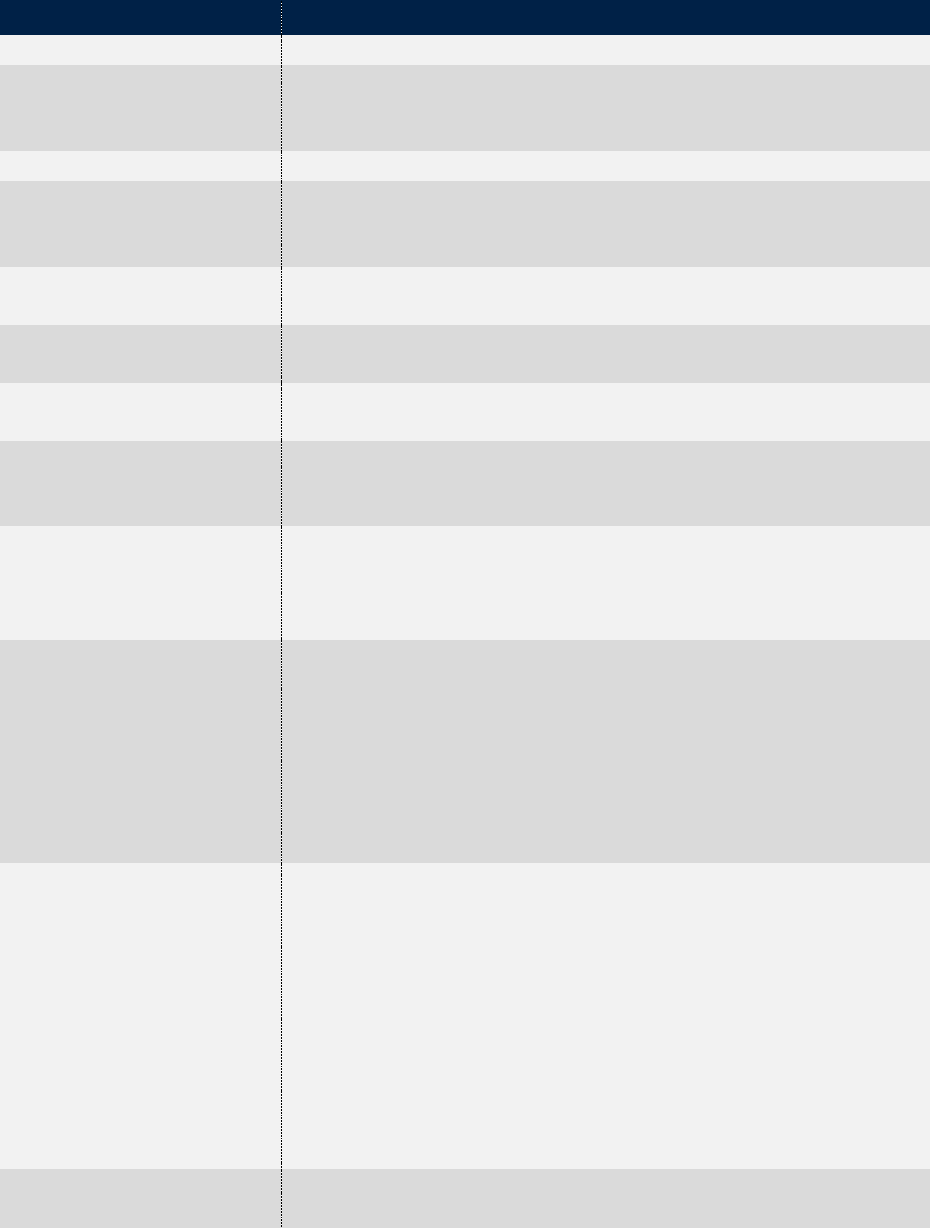
DBS Investment Management Guidance June 26, 2018
Department of Defense Page 48 of 54
Appendix G
DITIP
DITIP Data Element
Description (Sample Data)
FY
Budget year to be certified.
DBSs Covered
This data will initially be generated from SNaP-IT data. Values
are Yes or No. Yes if total for all resources for the FYDP years
is equal to or greater than $1M. Otherwise No.
Certification Cycle
Certification Cycle
Certification Request
Amount
The certification request funding amount for the appropriate FY
to be reviewed and certified by the appropriate approval
authority.
Certification Approved
Amount
The certification funding approved amount for the appropriate
FY approved by the DCMO or Military Department CMO
Comment – Certification
Request Amount
Rationale justifying certain request amount, if required.
Comment – Certification
Approved Amount
DCMO comment as to reason for approved amount, if required
Pre-Certification
Authority (PCA) for DBS
Program
Identify the appropriate PCA
BEA Version
BEA version used for compliance must be 10.0 for FY 2018 and
11.1 for FY 2019. Certification requests are based on BEA
assessments performed using IBF-DAP BEA Compliance
module.
BEA Compliant (NDAA
Business Enterprise
Architecture)
“Y”-Assessed-Compliant
“N”-Assessed-Not Compliant
“P” - Assessed-Planned Compliant
“X”-Assessment Not Completed
“L”-Legacy (Not Required)
Overall DBS compliance with the BEA should be based on the
outcomes of BEA compliance assessment performed in IBF-
DAP BEA Compliance module.
BPR Performed (NDAA
Business Process
Reengineering)
Appropriate BPR efforts have been undertaken to ensure that:
The business process supported by the DBS is (or will be) as
streamlined and efficient as practicable; and
The need to tailor COTS systems to meet unique requirements
or incorporate unique interfaces has been eliminated or reduced
to the maximum extent practicable.
“Y” – Yes, sufficient BPR efforts performed.
“P” - Yes, sufficient BPR efforts planned
“N” – No, insufficient BPR efforts performed
“L”-Legacy (Not Required)
Valid, achievable
requirements
“Y”- Assessed-Compliant
“P” - Assessed-Planned Compliant

DBS Investment Management Guidance June 26, 2018
Department of Defense Page 49 of 54
Appendix G
DITIP Data Element
Description (Sample Data)
“N”- Assessed-Not Compliant
“L” -Legacy (Not Required)
“S” In sustainment and didn’t have a compliant plan
Acquisition strategy
“Y”- Assessed-Compliant
“P” - Assessed-Planned Compliant
“N”- Assessed-Not Compliant
“L” -Legacy (Not Required)
“S” In sustainment & didn’t have a compliant plan
Compliance with the
DoD’s
auditability requirements
"Y”- Assessed-Compliant
“P” - Assessed-Planned Compliant
“X”- Assessment Not Completed
“N”- Assessed-Not Compliant
“Z” Not Applicable

DBS Investment Management Guidance June 26, 2018
Department of Defense Page 50 of 54
Appendix G
IBF-DAP
IBF-DAP Data Elements
for BEA use
Description
Data Elements, depending
on type of DBS
Core DBSs must complete a BEA Compliance Assertion in IBF-
DAP, which identifies and asserts compliance with all applicable
compliance requirements contained in the BEA.
Legacy DBSs are not required to assert compliance with
applicable BEA requirements, but they are required to perform
mappings in IBF-DAP to applicable BEA Operational
Activities, Business Capabilities, Processes, System Functions,
and E2Es.
Notes:
• Certification funding dollar amount requests will be entered into DITIP.
• For systems requiring migrations, the Lifecycle Phase: Start Date and End Date data is
also required for the migrating systems and the systems receiving the migrating
functionality (source and target systems).
• Migration data (e.g., Full / Partial Migration) should be provided for each migration.
• In order to complete the “Full/Partial Migration,” “Migration Comment,” “Target System
Identifier,” and “End Migration Date” fields, the Lifecycle Tab does allow a user to enter
a migration for DBS regardless of the Transition Plan State.
• Systems in DITPR must align 1:1 to the unique SNaP-IT Budget Unique Identification
Identifier (UII) and names and acronyms must match, with the exception of 9993
(Federal Contractor Incidental), 9994 (Base Realignment and Closure (BRAC)), 9995
(Crypto/C2/SAP/Intel) and 9997 (U.S. Army Corps of Engineers -Civil Works) and in the
DITIP they will be identified by their exception UII code and their DITPR ID. UII 9990
is not permitted for DBSs in DITPR, as these systems must be registered in SNaP-IT and
therefore have a unique UII.
• Select data will be pulled from DITPR and SNaP-IT to generate and pre-populate the
DITIP data for certification requests. This data includes the BEA, BPR, functional area
and system acronyms, as well as budget amounts. For DBSs in DITPR with no budget
amounts in SNaP-IT, DITIP will generate the ability to enter DM and CS certification
amounts.
• Because review and certification is for funds obligated within the fiscal year of the
certification, for funds obligated which are prior year funds, the program year is included
in DITIP.
• For DITIP values N, S, X, and Z, and for the set of compliance fields, there are comment
fields to briefly explain the basis for these determinations.
• DITIP also has user guides devoted to the DBS certification
• For all Planned Compliant values, enter planned compliance date. For S values, enter
comment.

DBS Investment Management Guidance June 26, 2018
Department of Defense Page 51 of 54
Appendix H
Appendix H: Investment Decision Memorandum – Sample
CHIEF MANAGEMENT OFFICER
9010 DEFENSE PENTAGON
WASHINGTON, DC 20301-9010
Date
MEMORANDUM FOR CHAIRMAN OF THE JOINT CHIEFS OF STAFF
UNDER SECRETARY OF DEFENSE FOR ACQUISITION,
TECHNOLOGY AND LOGISTICS
UNDER SECRETARY OF DEFENSE (COMPTROLLER) / CHIEF
FINANCIAL OFFICER
UNDER SECRETARY FOR PERSONNEL AND READINESS
UNDER SECRETARY OF DEFENSE FOR INTELLIGENCE
DIRECTOR, COST ASSESSMENT AND PROGRAM
EVALUATION
INSPECTOR GENERAL OF THE DEPARTMENT OF DEFENSE
DEPARTMENT OF DEFENSE CHIEF INFORMATION OFFICER
COMMANDER, UNITED STATES SPECIAL OPERATIONS
COMMAND
COMMANDER, UNITED STATES TRANSPORTATION
COMMAND
SUBJECT: Fourth Estate Organizational Execution Plan Investment Decision Memorandum for
FYxx Covered Defense Business Systems
References: (a) “Defense Business Systems Investment Management Guidance” Month xxx/
Year xxxx
(b) Title 10 Unites States Code Section 2222
Pre-Certification Authorities (PCAs) from Defense organizations other than the Military
Departments requested that the Defense Business Council (DBC) / Investment Review Board
(IRB) review and certify their portfolios of defense business system (DBS) investments as
identified in their Organizational Execution Plan (OEP) in accordance with reference (a). The
organizations will be referred to below as Fourth Estate Organizations.
The DBC / IRB convened a series of reviews, in accordance with reference (b), to assess the
Fourth Estate Organizations OEPs and recommended certification to the IRB Chair.
Decisions:
• Based upon the Fourth Estate PCA’s determinations in accordance with reference (b), and
related information provided for review, the DBS are certified for the specific amounts

DBS Investment Management Guidance June 26, 2018
Department of Defense Page 52 of 54
Appendix H
indicated in the “Certification Approved Total” column in the Defense Information
Technology Investment Portal.
• The DBC certified the FYxx certification requests for the DBS identified in Investment
Decision Memorandum (IDM) Attachment 1.
• The DBC did not certify the Development and Modernization investments for the DBS
identified in IDM Attachment 2, in accordance with reference (b). The PCA may request re-
review and certification upon approval of the corresponding documentation per the DoDI
5000.75 as validation of the associated DBS requirements.
• Part of the certification for the DBS identified in IDM Attachment 3 is certified to budget
projections in Select and Native Programming Data Input System for IT (SNaP-IT).
If additional funding is required, updated FYxx budget data should be reflected in the FYxx
budget update and a FYxx Out-of-Cycle (OOC) should be submitted.
• For any DBS cited in Attachments 1-3, additional actions may be included in order to
maintain data accuracy and currency in the systems of record. The action details are
provided as Attachment 4. These actions do not impact certification.
Fourth Estate Certification Thresholds:
• For the Fourth Estate portfolios, the Chief Management Officer (CMO) of the DoD serves as the
Chief Management Officer (CMO). In this capacity, the ODCMO will continue to review and
certify DBSs in accordance with reference (c). The threshold for the review and certification of
DBSs remains at $1M over the FYDP.
• This policy change includes annual reviews and Out-of-Cycle (OOC) reviews of a DBS
categorized as "Covered" by statute. OOC reviews may include investments previously certified
during an annual review but have changed during the period to modernize or update capability in
addition to adjustments in funding. Fourth Estate Organization PCAs must return to the DBC /
IRB to request certification for any additional business system investments that meet the criteria
in references (a) and (b).
Tasking / Action Items:
As a matter of policy, the PCAs of the portfolios must cite the results of any DBS review, to include
any associated information, in the authoritative sources used to document and manage the DoD
enterprise portfolio. These include:
• DoD Information Technology Investment Portal (DITIP)
• Defense IT Portfolio Registry (DITPR)
• Select and Native Programming Data Input Systems for IT (SNaP-IT)
• Integrated Business Framework – Data Alignment Portal (IBF-DAP)

DBS Investment Management Guidance June 26, 2018
Department of Defense Page 53 of 54
Appendix H
• As part of the FY18 President’s budget process:
• Correct SNaP-IT issues identified in IDM Attachment 2;
• Ensure Prior Year (FY16) amounts in SNaP-IT reflect actual obligations; and
• Ensure budgeted funds in SNaP-IT do not extend beyond the sunset date for Legacy systems.
Discussion: Certification of funds does not provide obligation authority. Certification for DBS
with unfunded requirements is subject to the availability of funds. The Fourth Estate Working
Group will serve as the conduit for the acceptance, resolution, and approval of any conditions
placed by the Chair of the Investment Review Board.
Point of Contact: The point of contact for the Investment Decision Memorandums is Mr./Ms.
Name, email[email protected] or (555) 555-5555.
Deputy Chief Management Officer
Investment Review Board Chair
Attachment:
As stated

DBS Investment Management Guidance June 26, 2018
Department of Defense Page 54 of 54
Appendix I
Appendix I: References and Resources
Links to reference and resources, including data repositories, are provided below. Public
websites do no require authorized access. All other links require a CAC; futher authorization is
required to access DoD data repositories such as DITPR, SNAP-IT, DITIP and IBF-DAP.
• CMO: http://dcmo.defense.gov/ (DoD CMO’s public website)
• DBC charter: http://dcmo.defense.gov/Governance/Defense-Business-Council/OEPs
• IBF-DAP: It is only for CAC-registered users. https://bea-etools.osd.mil/ee/
• IDMs: It is only for CAC-registered users. https://dcmo.osd.mil/coi/ibf/default.aspx
• ASP:
http://dcmo.defense.gov/Publications/DoD-ASP/ASP
• BEA: http://dcmo.defense.gov/products-and-services/business-enterprise-architecture/
• BPR: http://dcmo.defense.gov/products-and-services/business-process-reengineering/
• BCAC DCMO certification portal link: It is only for CAC-registered users.
https://dcmo.osd.mil/coi/PS/PPS/SitePages/Home.aspx
DoD authoritative data sources: Access these data repositories if more information is required.
Additional access priviledges are required for each repository.
• The Integrated Business Framework: The link below provides access to Functional
Strategies, OEPs conditions and IDMs. It is only for CAC-registered users.
https://dcmo.osd.mil/coi/ibf/default.aspx
o Contact: osd.pentagon.odcmo.mbx.irb-support-staff@mail.mil for OEP
submissions, OOC submissions, and related correspondence.
o Contact: osd.pentagon.odcmo.mbx.irb-support-staf[email protected] for questions
regarding this guidance or the OEP.
• DITPR: https://ditpr.dod.mil/dodcio/DITPR/MenuDITPR.cfm It is only for CAC-registered
users.
• SNaP-IT: https://snap.cape.osd.mil/snapit It is only for CAC-registered users.
• DITIP: https://snap.cape.osd.mil/ITPortal
It is only for CAC-registered users.

